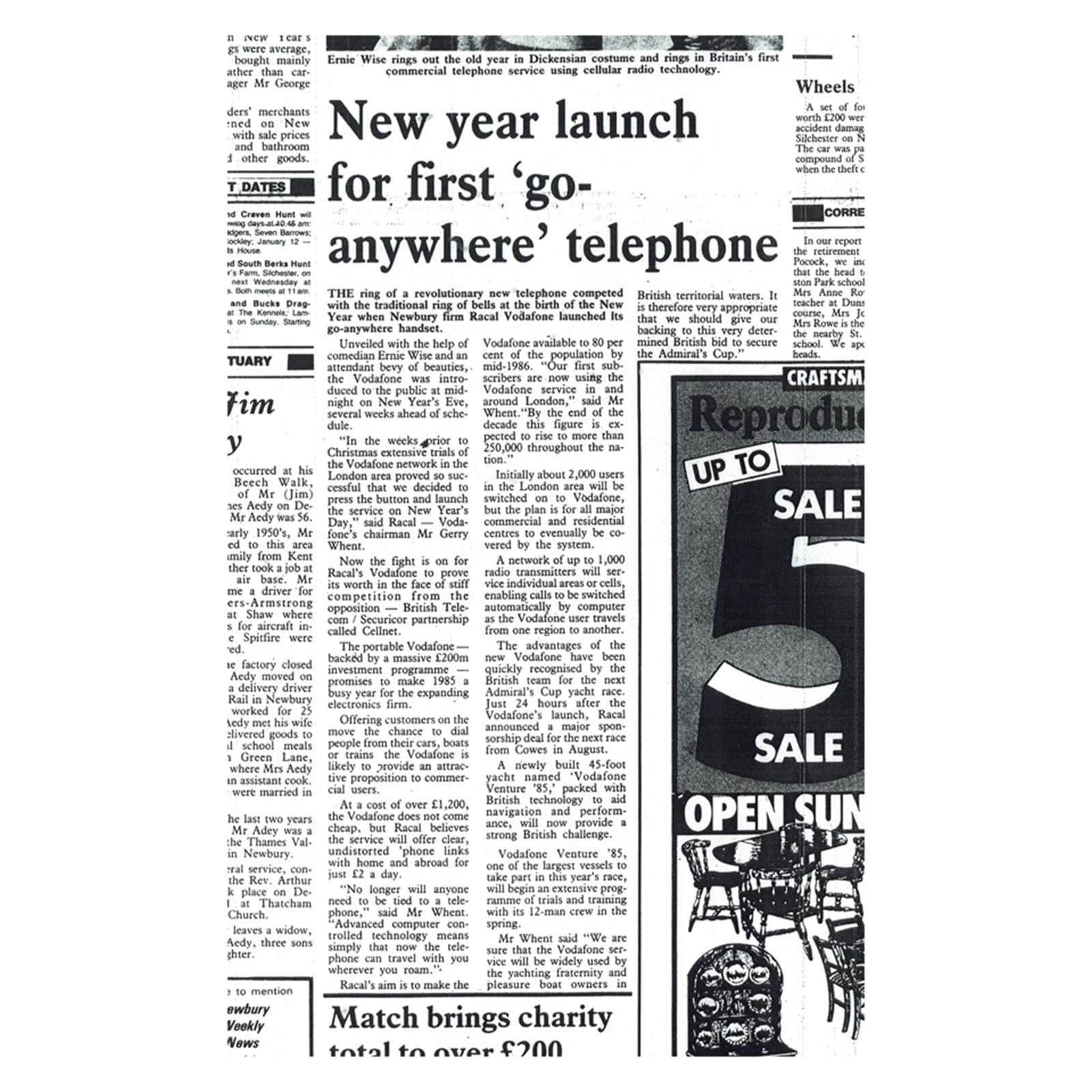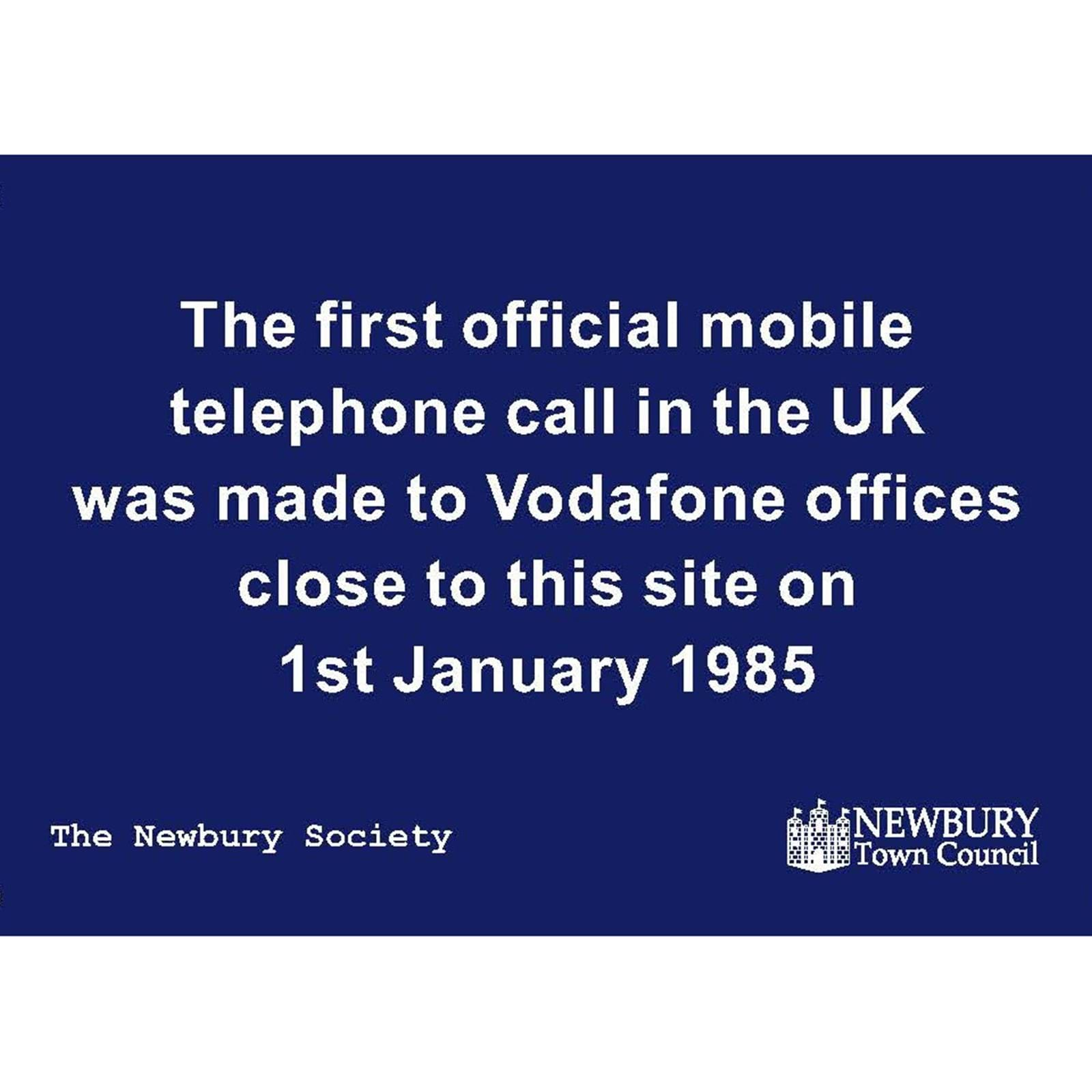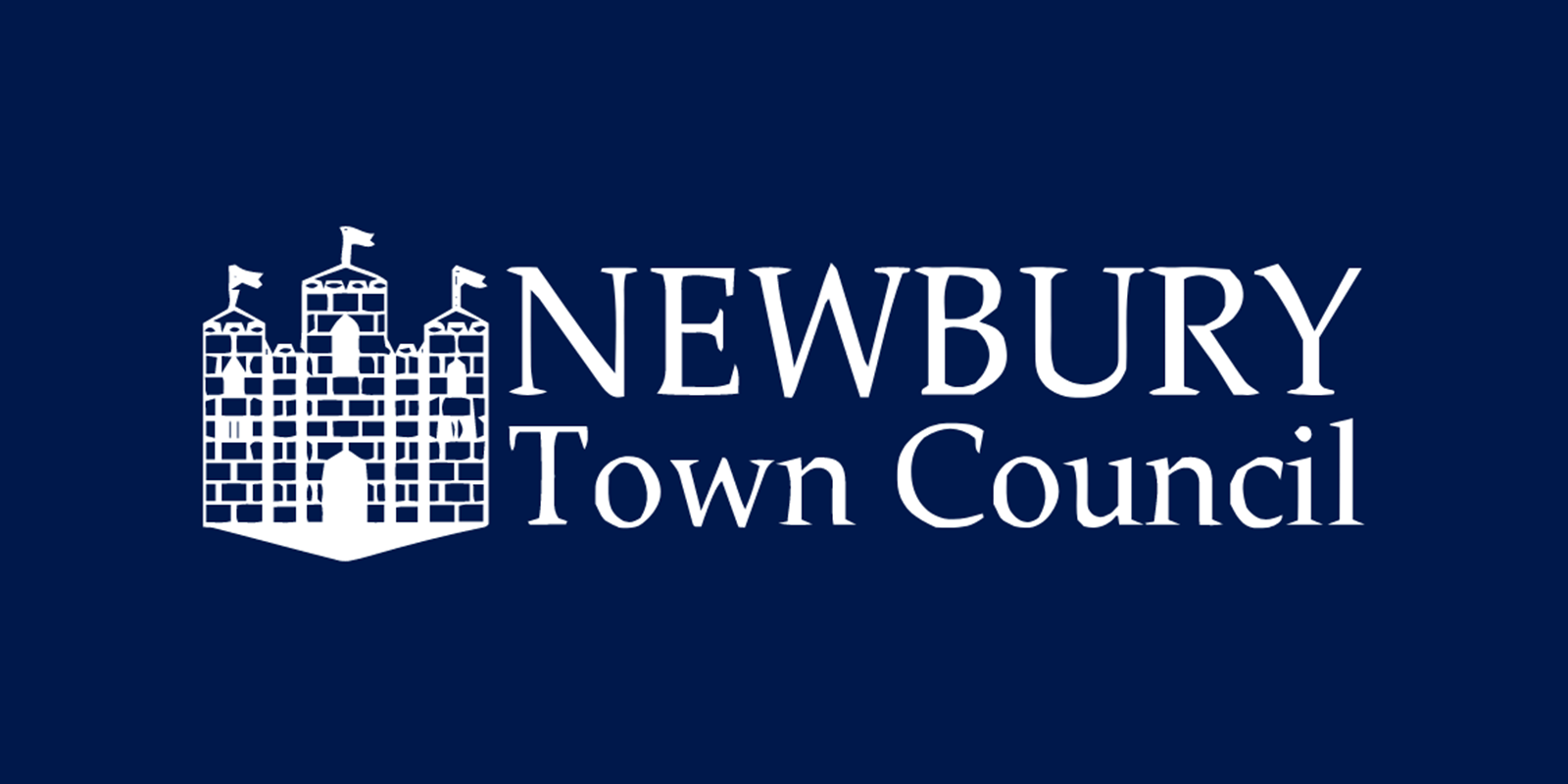
Celebrating Newbury’s History
Newbury Town Council Blue Plaques in conjunction with the Newbury Society commemorate the lives of significant Newbury residents through the ages and mark where they lived or worked.
These plaques also celebrate businesses and industries who have had a significant impact on the town of Newbury.
Location: Carnarvon Place, Andover Road, RG14 6LP
Albert Alexander, an Abingdon Policeman who had served in Newbury, was the first person to be treated with Penicillin. Although unfortunately the treatment did not succeed, his place in the history of antibiotics is secure.
He was born in 1897 in Woodley, Reading, the fourth child of Edward Alexander, a farm labourer, and his wife Emma. He joined up at World War I, and served in the Army Service Corps, 101st Company ASC, 14th Divisional Train, providing horse transport to the front line in France or Belgium.
In 1921, Albert joined the Berkshire Constabulary, and from 1923 to 1929 was stationed in Newbury. In 1924 he married Edith Mary Deacon at St Mary’s Church, Speenhamland. They lived in Newbury and had two children. In 1930 he was transferred to Thatcham and in 1937 to Wootton, near Abingdon.
At the outbreak of World War II, he was assigned to the Force’s Mutual Aid Team, on standby duty to go anywhere in the country. On 30th November 1940 he was in Southampton supporting the Southampton Police, when he was injured in an air raid on the Police Station. He developed blood poisoning and was transferred to the Radcliffe Infirmary in Oxford, where it was decided to treat him with Penicillin. At the time of his treatment the effects of a large-scale injection were not known, but Albert’s Staphylococcus and Streptococcus septicaemia was so severe that the action was considered justified. He immediately showed a great improvement, but sadly not enough Penicillin had yet been isolated and he died on 15th March 1941.
Albert was buried in the Newtown Road Cemetery, where he was joined by his wife Edith Mary, who died in 1985 aged 89.
Sources:
National Association of Retired Police Officers May 2004
Friends of Newtown Road Cemetery
British Medical Journal 22-29 December 1984
Ancestry
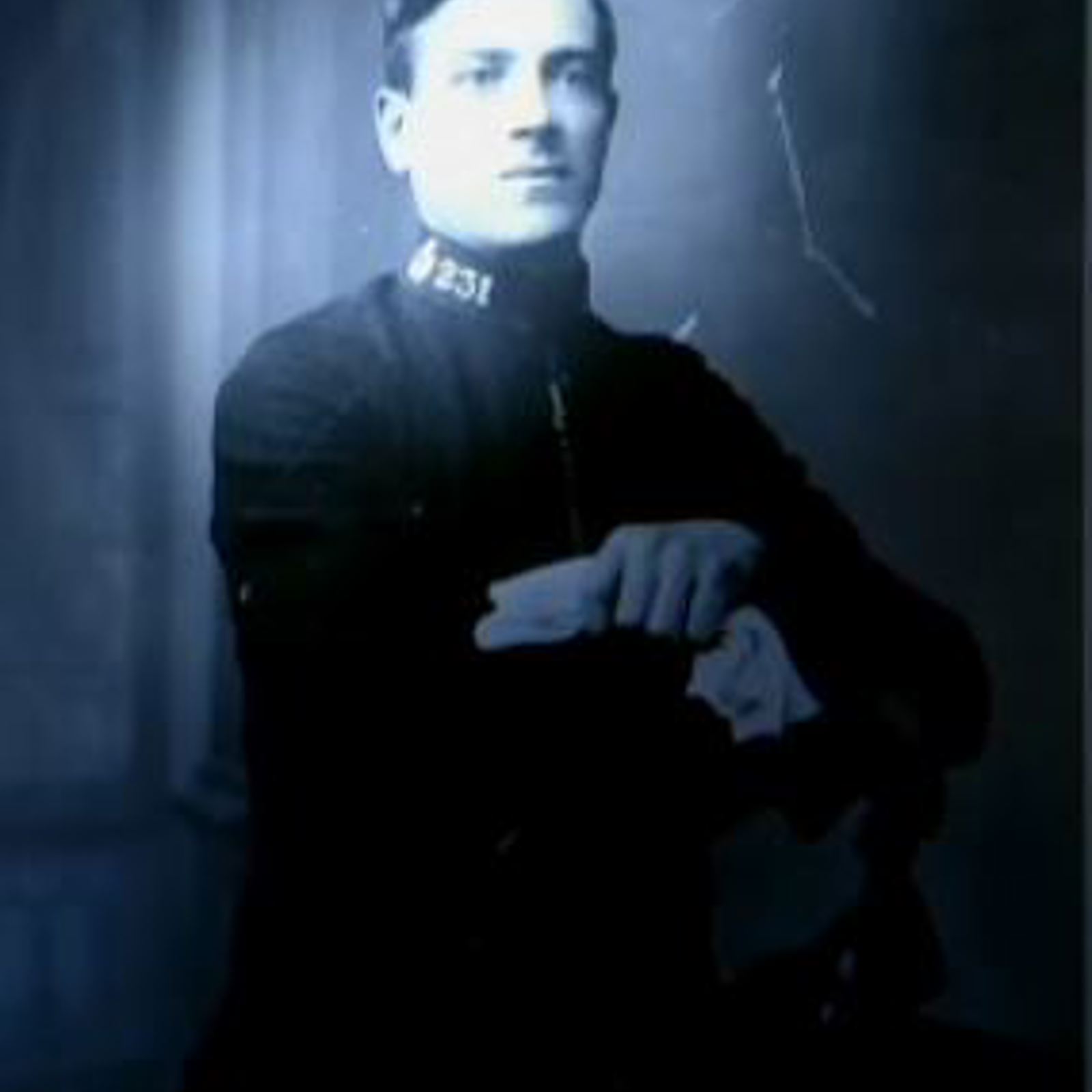

Location: 62 Northbrook Street
Francis Baily (1774-1844) was an eminent astronomer, the son of Richard and Sarah Baily. The Bailys are a Thatcham family, and their family vault lies at St Mary’s Church, Thatcham. However, Richard Baily had moved to Newbury to engage in business as a banker, coal merchant, and barge master, and served as Mayor of Newbury 1773-74. Francis was born at his house at 62 Northbrook Street (since rebuilt).
After a tour in the unsettled parts of North America, Baily entered the London Stock Exchange in 1799. He earned a high reputation as a writer on life contingencies and amassed a fortune which enabled him to retire from business in 1825, to devote himself wholly to astronomy. He took a leading part in the foundation of the Royal Astronomical Society in 1820 and was elected its President four times (1825–27, 1833–35, 1837–39 and 1843–45). His fame as an astronomer rests on his discovery of “Baily’s beads” in 1836. During an eclipse of the sun by the moon, the irregular shape of the moon’s limb allows beads of sunlight to shine through in some places around the moon’s profile, but not in others. He observed the phenomenon again at Pavia during the solar eclipse of 1842, starting the modern series of eclipse expeditions.
In other work, Baily superintended the compilation of the British Association's Catalogue of 8377 stars (published 1845), and revised the catalogues of Tobias Mayer, Ptolemy, Ulugh Beg, Tycho Brahe, Edmund Halley and Hevelius. He completed Henry Foster's (1797-1831) pendulum experiments, deducing from them an ellipticity for the earth of 1/289.48. This value was corrected for the length of the seconds pendulum by introducing a neglected element of reduction, and was used in 1843 in the reconstruction of the standards of length. His laborious operations for determining the mean density of the earth, carried out by Henry Cavendish's method (1838–1842), yielded the authoritative value of 5.66. He published at his own expense a detailed account of the work of the first Astronomer Royal, Sir John Flamsteed.
Baily lived at 37 Tavistock Place, London. He was elected a Foreign Honorary Member of the American Academy of Arts and Sciences in 1832. The lunar crater Baily was named in his honour, as were the rigid and thermally insensitive alloy (Baily’s metal) used to cast the 1855 standard yard, and the Francis Baily Primary School in Thatcham.
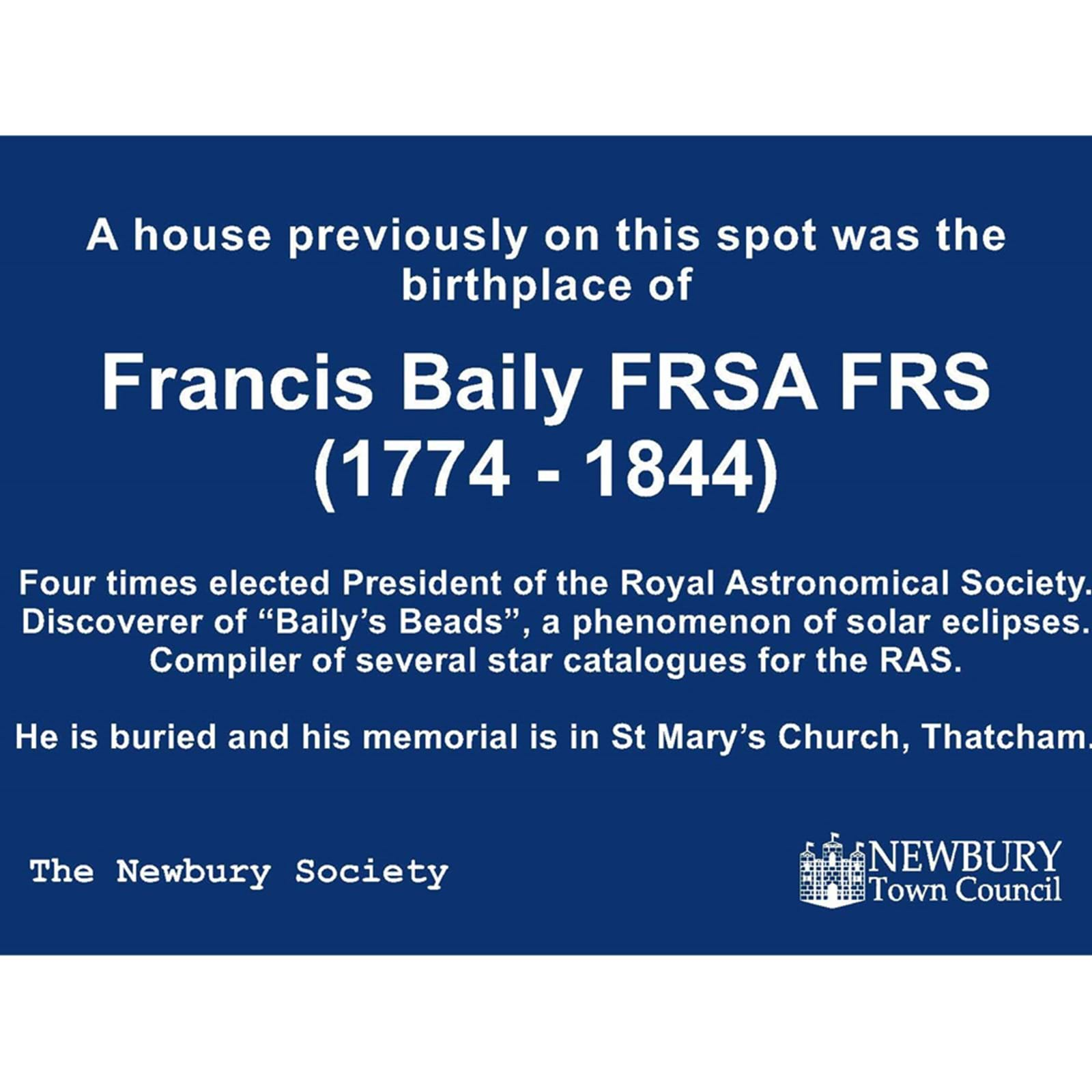
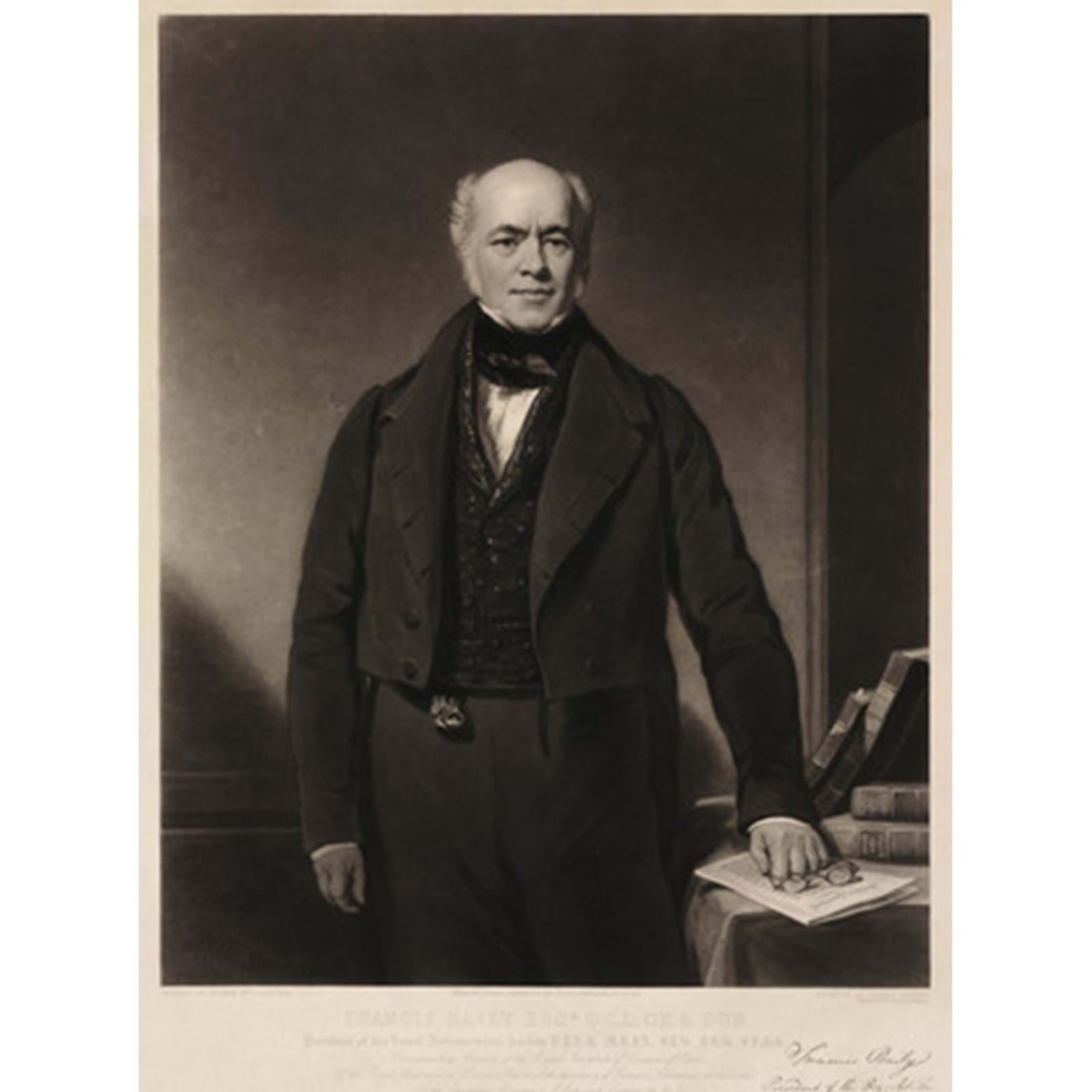
Location: The gate post of Greenham House, the premises of Newbury Gardens Day Nursery, Greenham Road, RG14 7HS
James Bicheno was a local campaigner against the slave trade in the late 18th century, actively promoting two petitions from Newbury to Parliament to ban slavery. He was also the Baptist minister of Newbury for 27 years and a local schoolmaster.
He was born in the village of Over, Cambridgeshire, in January 1752, the eldest child of William Bicheno (1723-1806) and his wife Elizabeth Frith (1728-61). William was a glover and breeches maker, and farmed some land. His Bicheno ancestors had been resident in Cambridgeshire since the 16th century. The name is believed to be of Flemish origin. Over had a Baptist Church, built in 1737, but it not known whether the Bichenos were Baptists.
James Bicheno was baptised into the Baptist church in Cambridge in 1768. He attended Cambridge University, but left university after a year in 1769, the same year he was “cut off” by the Baptist church. About 1770 he travelled to America, and subsequently claimed that he had been sold as an indented servant in Virginia, after falling victim to deception. His master is said to have been a member of the Virginia Council of State, or “Governor’s Council”. One account states that after various privations, including time spent living with his master’s slaves, Bicheno was accepted into his master’s household as his children’s tutor. In due course he was redeemed by his friends and returned to England.
In 1774 he reappeared at the Cambridge Baptist Church and was accepted back, and in 1776 he was recommended by them for training for the ministry at the Bristol Baptist College. The errors in his past life had been overlooked, and the Church had been impressed by his enthusiasm and potential. He attended Bristol and was ordained in 1778. The same year he was appointed Baptist minister at Falmouth, and after 18 months there became the Baptist minister at Newbury in 1780. He continued as Newbury’s minister for 27 years, until he resigned in 1807.
The Society for the Abolition of the Slave Trade was formed in 1787, and the following year organised its first national campaign of petitions to the House of Commons for the abolition of the trade. Rev. James Bicheno is understood to be the author of an advertisement in the Reading Mercury (then the local newspaper) in March 1788, which appealed to “the inhabitants of Newbury” and described the conditions of slavery: “Hundreds of men, women and children are crowded into the hold of a ship, exposed to the despotic will, the lust and cruelty of unfeeling seamen; and all this is aggravated by the dreadful uncertainty which lies before them. multitudes perish on their passage; those who survive are sold as cattle, to be slaves for life...”
The advertisement resulted in a public meeting held on April 7, 1788 at the Mansion House in the centre of Newbury (Newbury’s town hall at the time). The Mayor of Newbury, aldermen, burgesses and inhabitants of Newbury were “deeply impressed with the injustice and inhumanity of the Slave Trade,” and called for it to be stopped by any practical means. They petitioned the House of Commons to take “such measures as shall to your wisdom and humanity appear best calculated for bringing to a speedy end, the horrors of a commerce which is disgraceful to our national character, and by which we become the instruments of misery to innumerable multitudes of our fellow creatures.”
The meeting gave a vote of thanks to the Mayor, John Hasker, for agreeing to the request to call the meeting, and to Mr Bicheno, “for his great attention to this common cause of humanity” (although in the newspaper report his name was mis-spelt as the “Rev. Bickens”). The petition was presented to Parliament, along with over 100 other petitions from all parts of England, but the House of Commons decided not to respond.
In 1792 Bicheno was one of ten people who called for the Mayor of Newbury to hold a public meeting to consider a second petition. A meeting was held at the Mansion House on March 5, and decided to present a petition to the Commons against “...the very great Enormity of this abominable Traffic in Human Flesh... which involves not only the Justice of our Country but the Happiness of Millions of our Fellow Men.” It stated:
“...We have the firmest Convictions that no Considerations either of Gain or Policy can exculpate this Nation from the foulest guilt in permitting a Commerce to exist which violates the most sacred Laws of Justice and Humanity, disgraces us as a People glorying in the exercise of Liberty and which dishonours us as Christians professing a religion that breathes Peace and Good Will to all Men.
Permit us then most earnestly to beseech your Honourable House to adopt such Measures for abolishing so iniquitous a Traffic as to the Wisdom of your Honourable House shall appear most meet, that thus we may avert the Indignation and have a rational ground to hope for the Blessing of the benevolent Creator the common Father of the Human Race.”
This petition was signed by 333 Newbury people, with the Mayor Joseph Toomer and Bicheno among those at the head of the list. It was handed over to Berkshire MP Winchcombe Henry Hartley, who with fellow MP George Vansittart was asked to present it to Parliament, which they did on March 16, 1792. This time the Newbury petition was one of over 500 petitions in a larger national campaign co-ordinated by the Society for the Abolition of the Slave Trade.
The continuing campaign had a major success with the Slave Trade Act 1807, but it was not until the Slavery Abolition Act 1833 (3 & 4 William IV c.73) that slavery was abolished throughout the British Empire.
In 1783 Bicheno married Ann Hazell (1749-1814) at Wantage, and they had two children who survived to adulthood: James Ebenezer Bicheno and Elizabeth Frith Bicheno (later Elizabeth Francis). Around 1796 he also started a boys’ boarding school, at Greenham House, then in Greenham, and he continued running it until 1811. The school seems to have made him prosperous. His son was able to train as a barrister and to continue in a life of relative ease until he joined the colonial service aged 57, and in his will he left £2200 in cash to provide an income for his daughter and her husband.
In 1811 Bicheno left Newbury to serve the Baptist community in Aston near Witney, where his wife died in 1814. He returned to Newbury in 1819, staying in the town for the rest of his life. He died at home in London Road, Newbury, on April 9, 1831, and was buried in the “family vault” at Wantage.
He published a number of religious books and articles, including 11 pamphlets relating Biblical prophecies to European events during the French revolutionary and Napoleonic periods. He was awarded a Master’s degree by Brown University, Providence, Rhode Island in 1796. He was also a very early supporter of the Baptist Missionary Society.
His son James Ebenezer Bicheno (1785-1851) became Governor of Van Diemen’s Land (Tasmania), and the Tasmanian town of Bicheno is named after him.
DP/ACP
Newbury, Dec. 2020
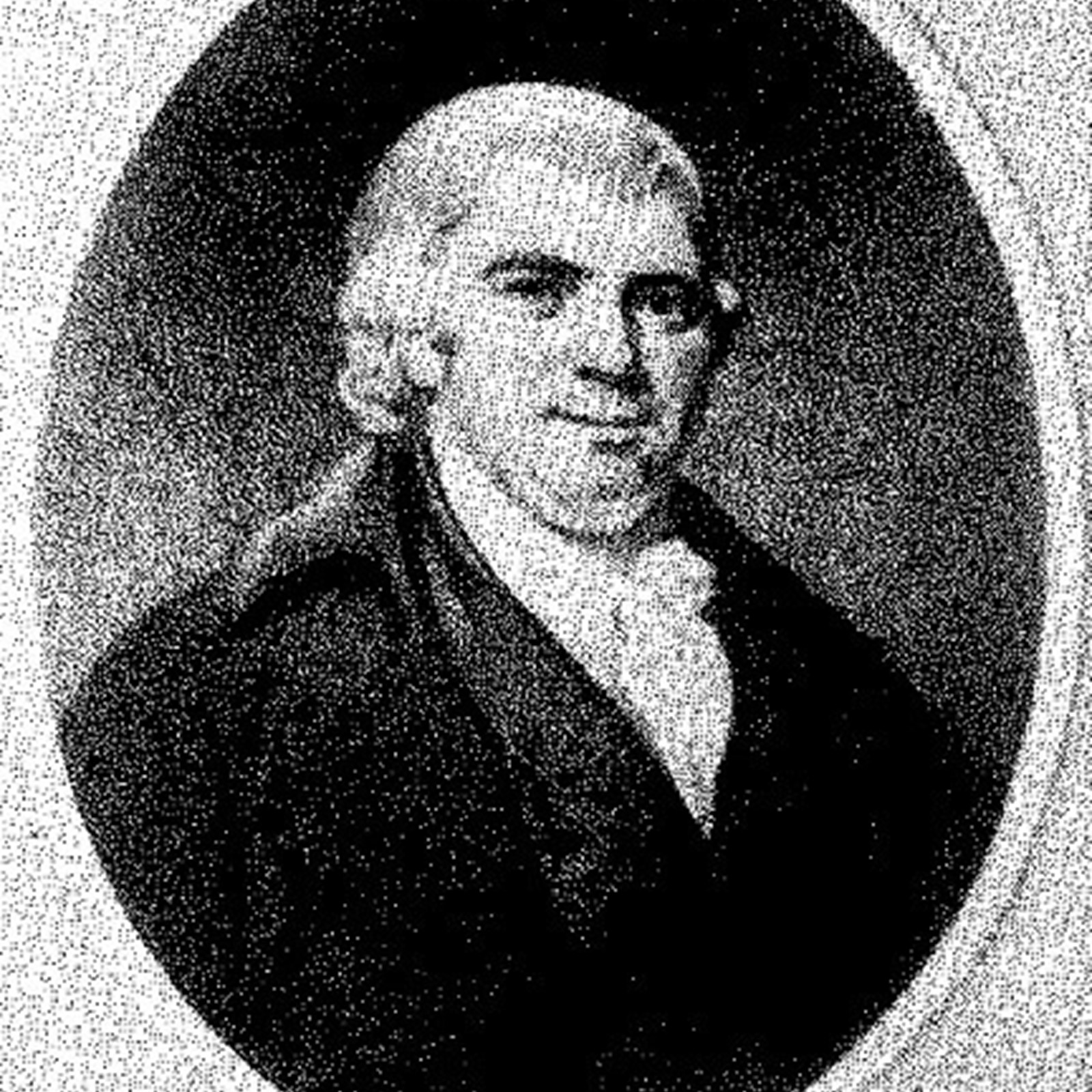
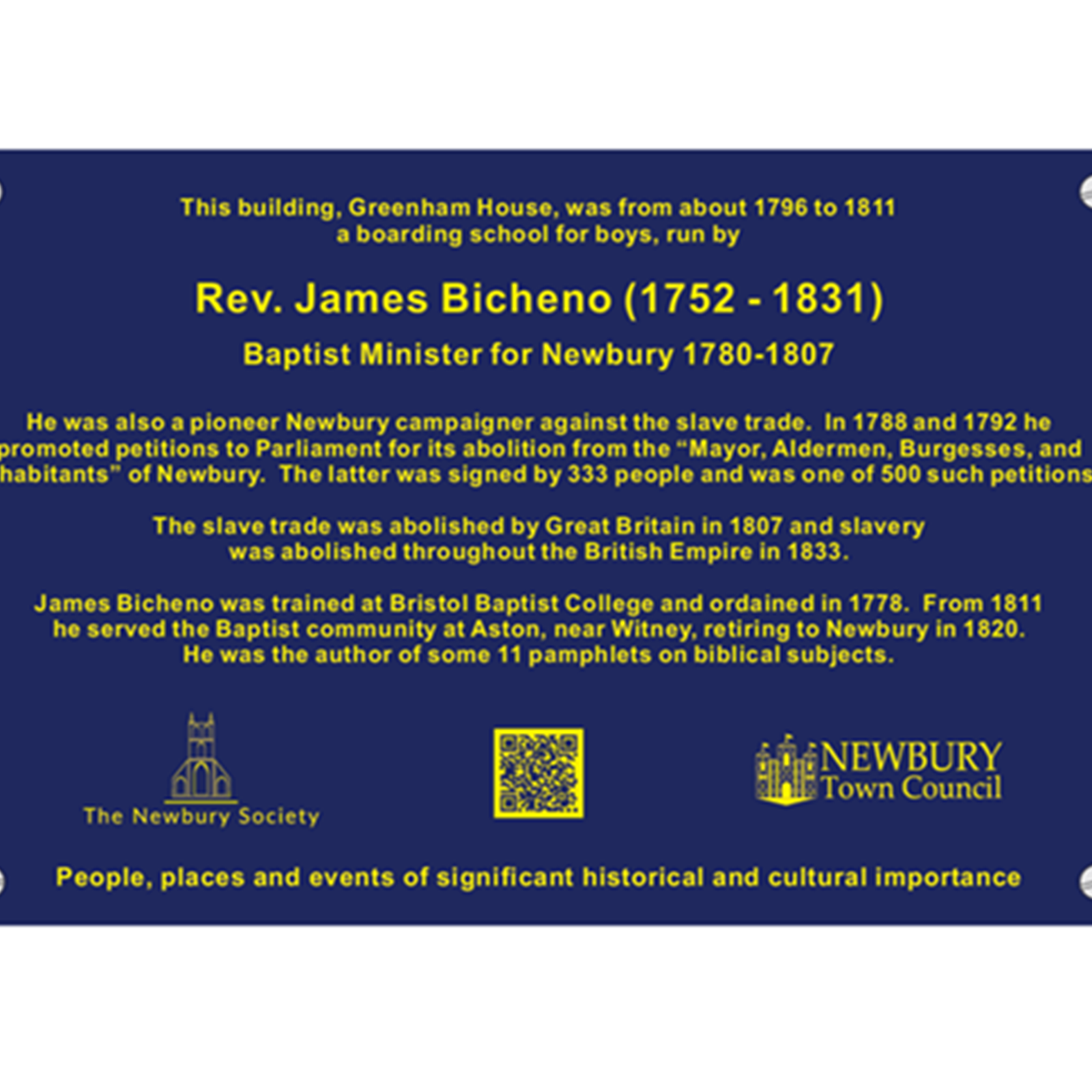
Location: Victoria Park Tennis Courts
Charlotte (Lottie) Dod was an outstanding female British sportswoman of the pre-First World War era, and one of the most versatile of all time. She was born in Cheshire, the daughter of a wealthy Liverpool cotton broker. She initially excelled at tennis, winning the Wimbledon ladies championship in 1887, 1888, 1891, 1892, and 1893. Proceeding to other sports, in 1904 she won the British Ladies Amateur Golf Championship and played twice for the England women's national hockey team, which she helped to found. In 1905 she and her brothers moved to Edgecombe, Andover Road, Newbury (now the site of Woodridge House) and lived there until 1913, when they moved to Devon. While in Newbury she joined the Welford Park Archers, and won the women’s silver medal in archery at the 1908 Summer Olympics. Other sports which she mastered were the Cresta Run, skating, rowing, sculling, horse-riding, mountaineering, and billiards.
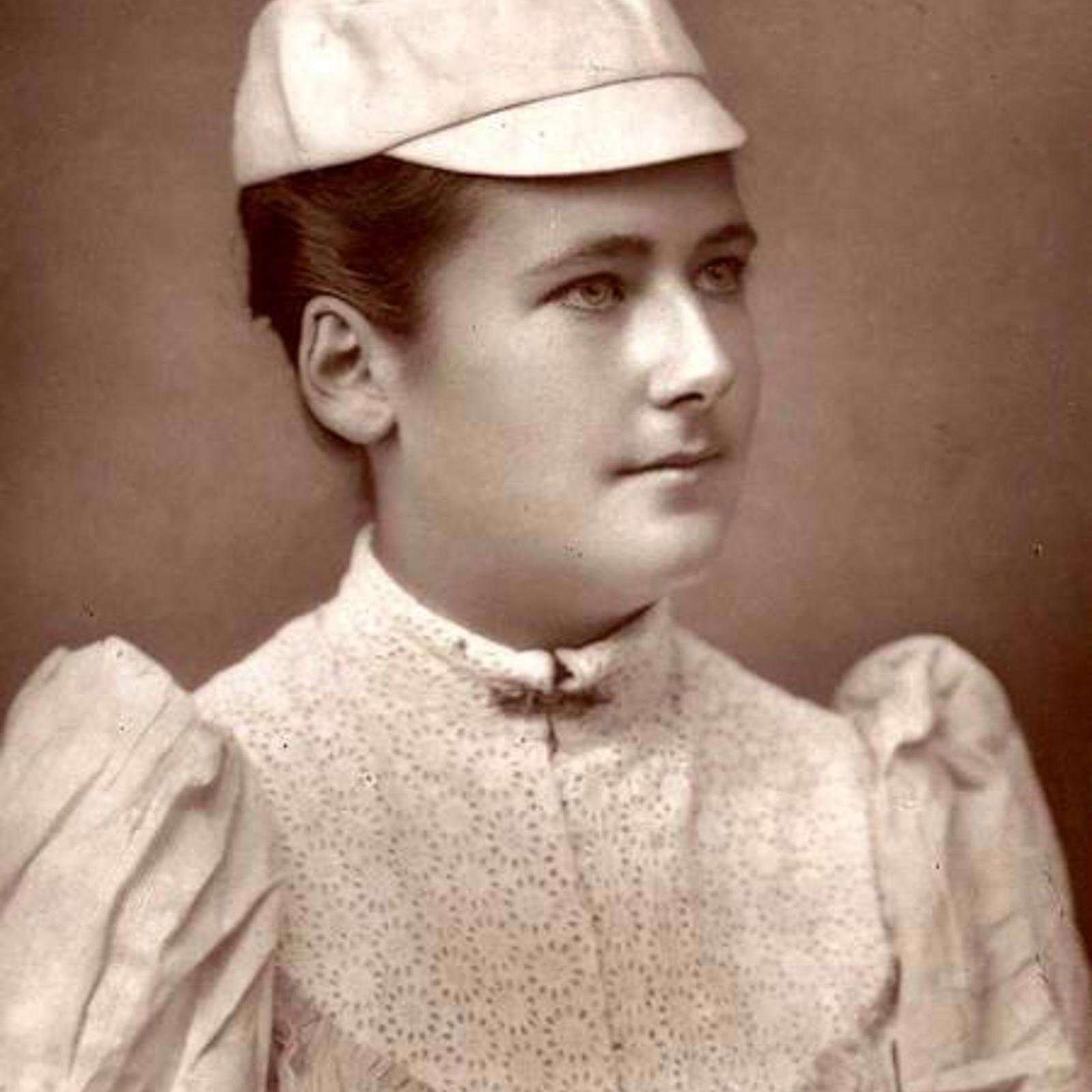
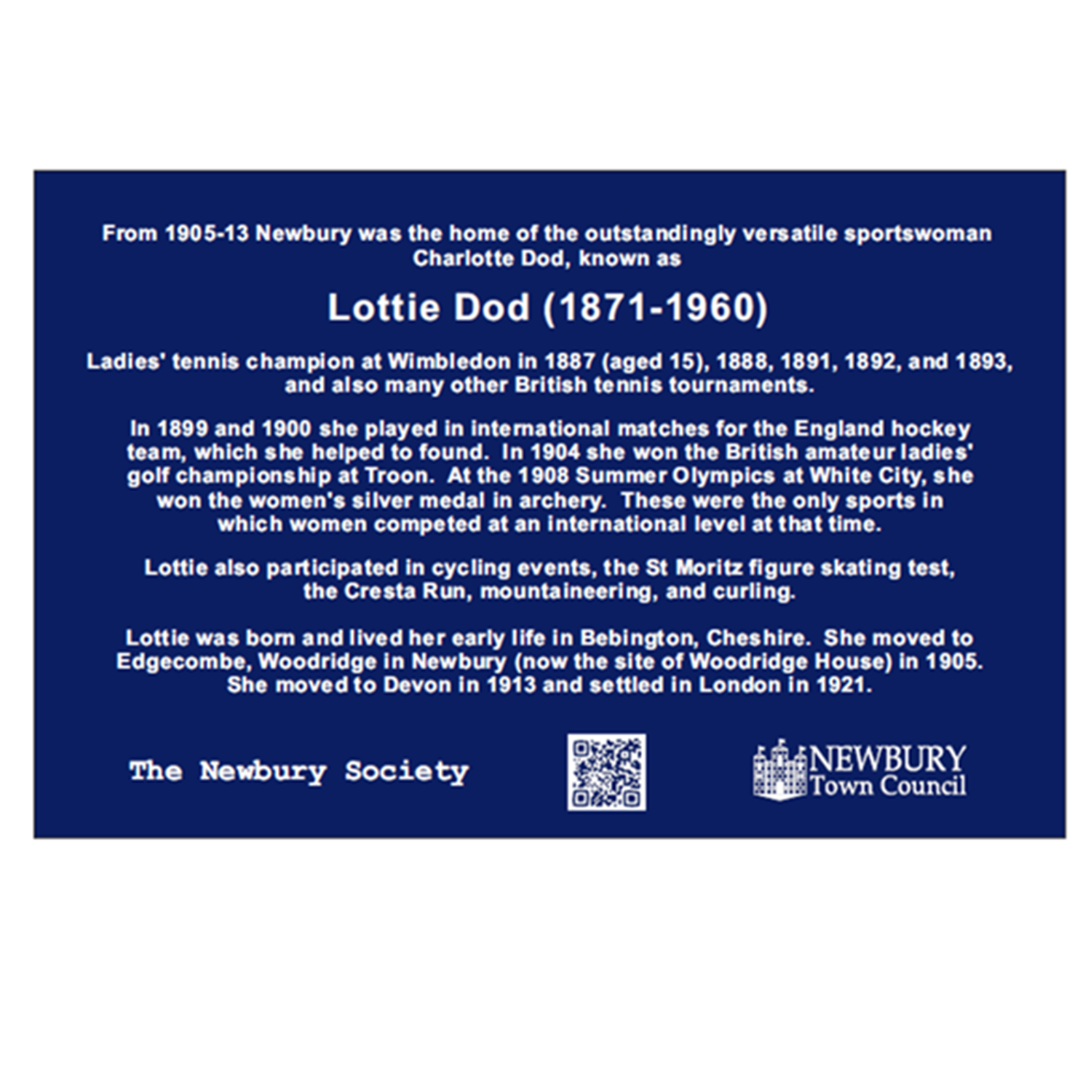
Location: Chequers Hotel, Oxford Street.
The Chequers Hotel is featured in Thomas Hardy's (1840-1928) novel "Jude the Obscure" (1895) which takes place mostly in and around Newbury and Oxford, disguised under the fictional names "kennetbridge" and "Christminster". The topography of Newbury at that time is accurately described, where Northbrook Street is the "long straight street of the borough". The Chequers Hotel is expressly mentioned as a favourable place to stay.
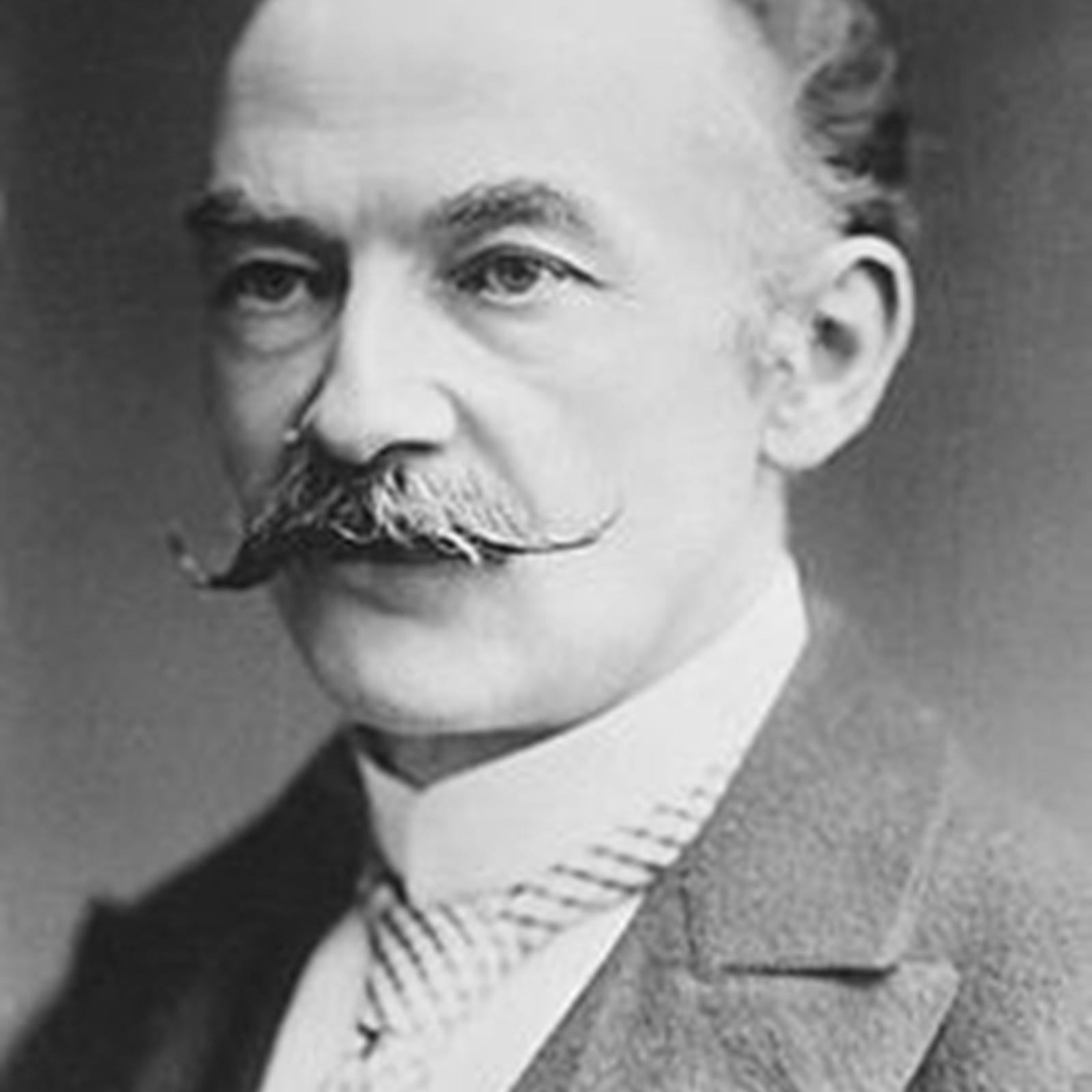
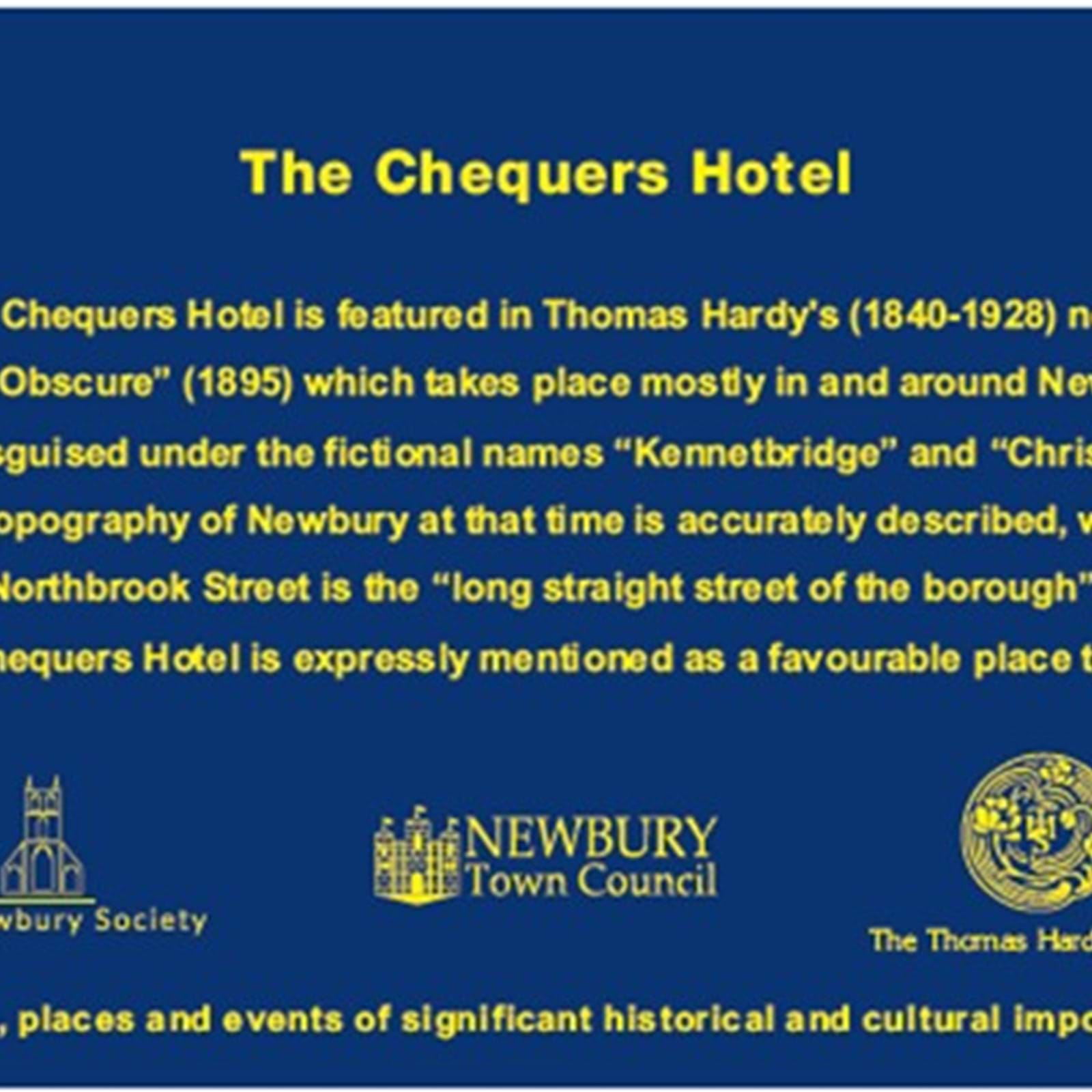
Location: Hillier and Wilson Estate Agents, Bartholomew Street
This plaque commemorates Elsie Kimber (1889-1954), who in 1932 was elected as the first female Mayor of Newbury since the Borough was created in 1596. The plaque is located at 64 Bartholomew Street, now Hillier & Wilson Estate Agents, but formerly Kimber’s Grocery and Provision Merchants, informally called “Kimber’s Corner”, which she ran from 1939 until her retirement in 1953.
Elsie Kimber was a pioneer in our local government. The road had been steep. Although women had been permitted to be elected as local Councillors and to serve as Mayor and Aldermen in 1907, full national gender equality for voting purposes was only granted in 1928. Elsie was elected the first female Newbury Town Councillor in 1922 and was appointed its first female Alderman in 1943. The next female Mayor, Ethel Elliott, was not elected until 1953, and it was not until 1993 that female Mayors were addressed as “Madam Mayor”. Until then, the term “Mr Mayor” was so ingrained that it was used even for women.
Elsie Kimber was born at 64 Bartholomew Street and was one of the first intake to the Newbury County Girls’ School when it opened in 1904. She joined her father, Ernest Kimber, in his grocery business and ran it after his death until she retired. She was also the first woman delegate to the All England Grocers' Conference. During the Second World War she served as an ARP Warden. Her interests as a Councillor included housing, slum clearance, public health and education. She taught swimming to children, and her reputation was of “one who had an infinite capacity for taking pains".
In his 1990 autobiography, the author Richard Adams wrote: “Alderman Elsie Kimber was a legendary figure in Newbury. She had rimless glasses, wore a heavily-skirted, brown belted garment, sandals and no hat, and she rode a motor-bike. She was emancipated, bizarre, no fool and excellent company, even to a small boy. To me it seemed entirely natural that the Mayor should look somewhat unusual. I vaguely supposed that that was what mayors looked like.”
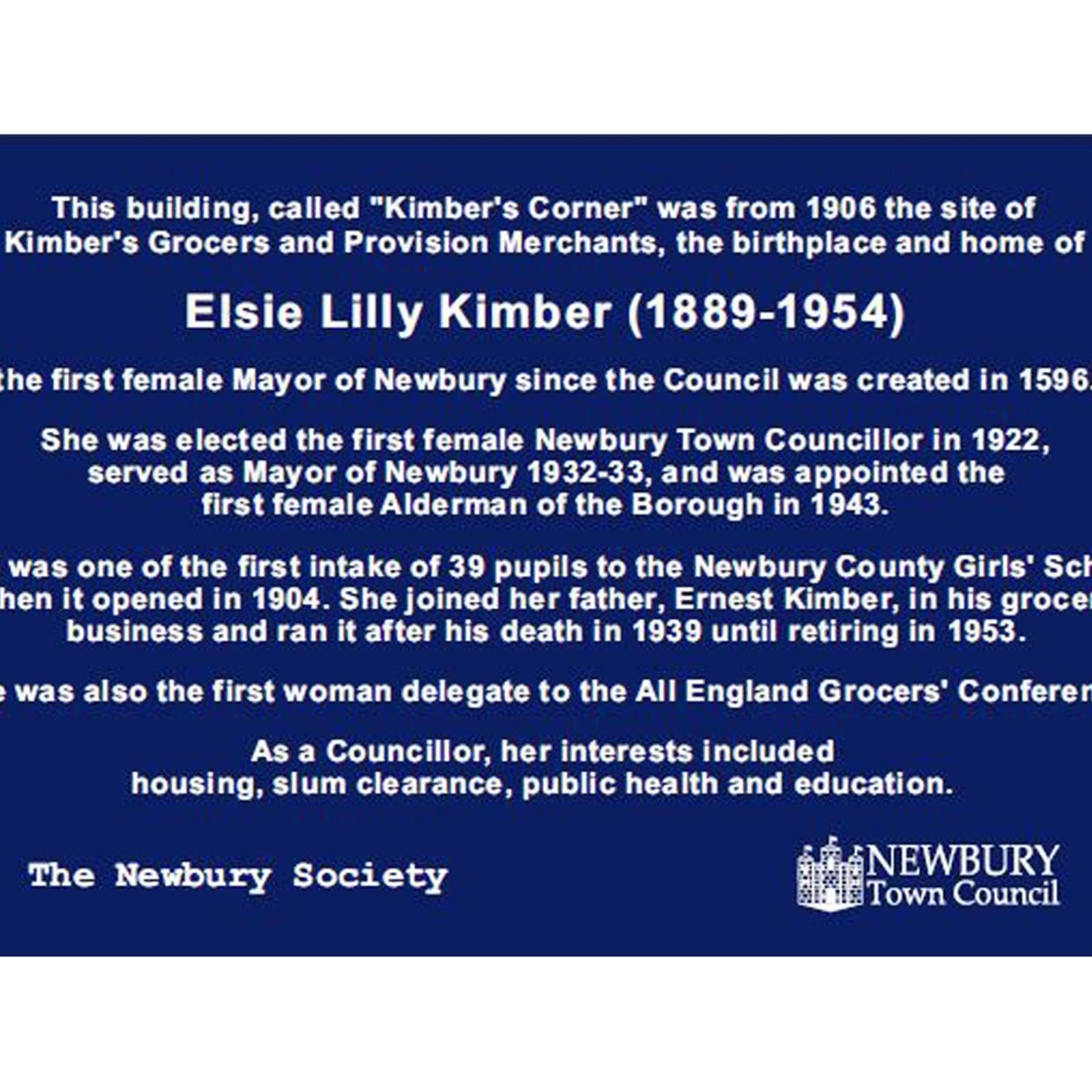
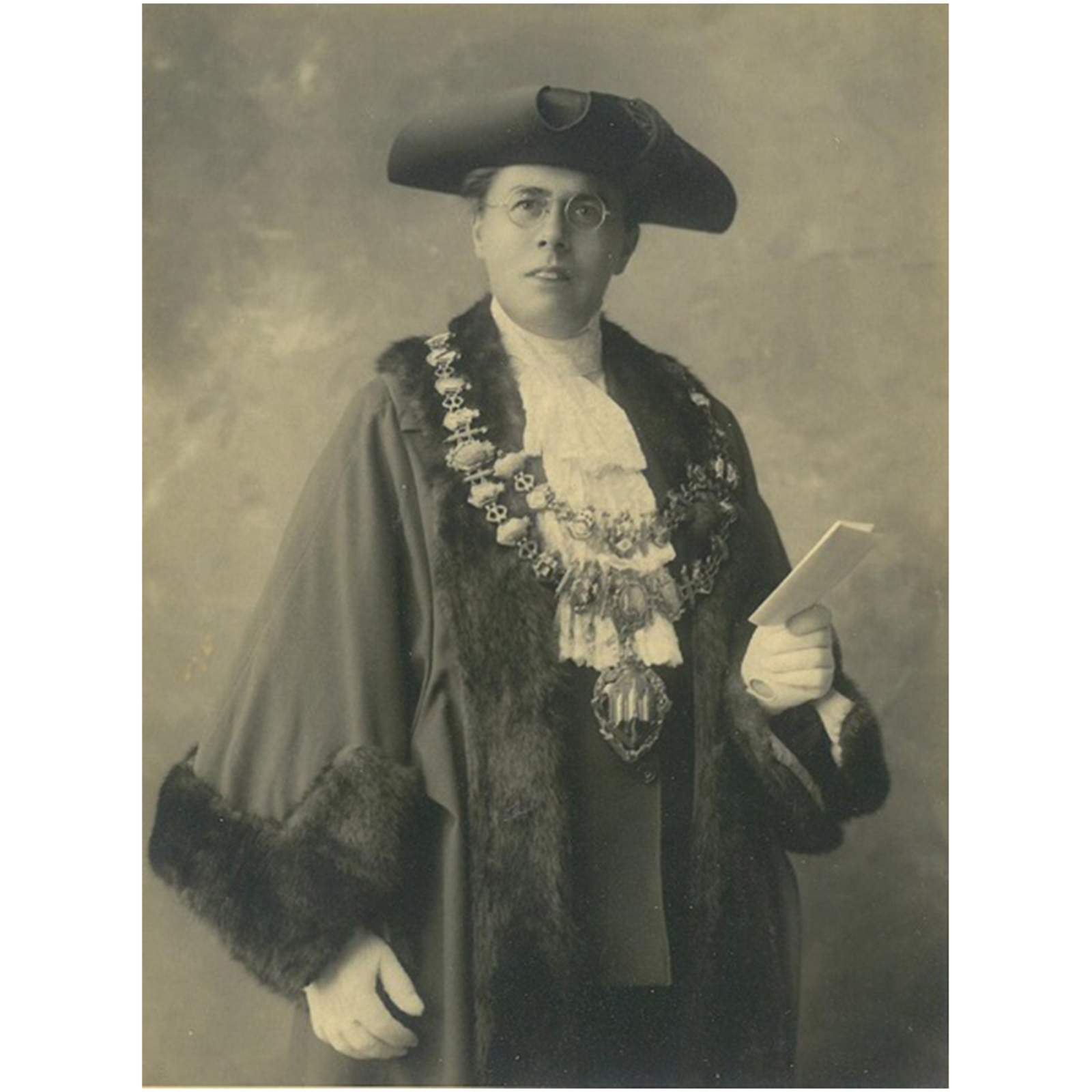
Location: Luker Court, Ireland Drive, RG14 6EG
Esther Jane Luker, who generally used the name Jane, was the first Headmistress of Newbury Girls’ School from its foundation in 1904 until her retirement in 1933, and a pioneer of secondary education for girls in Newbury and the surrounding area. She believed in a broad-based education that, although rigorous, would not be narrowly academic but would embrace a love of art and music. Under her leadership, the school gained an excellent academic reputation and presented its students with opportunities to explore new ideas, travel abroad and involve themselves in sport and social service through its involvement with the Peckham Settlement in East London. It produced women who were well educated, served their community and achieved success in various fields. Among them was Elsie Kimber, the first woman mayor of Newbury.
Jane was born on 2 September 1872 in Southend, the daughter of Robert Luker and his wife Esther. In 1875, her family acquired a brewery in Petersfield. From 1881-91 she attended as a boarder Dulwich High School, where she became Head Girl and Captain of Games. Through a scholarship, she entered Girton College, Cambridge, where she gained a degree in Mathematics and was also Games Captain. Her first teaching positions before being appointed Headmistress at Newbury were at Sheffield High School and St Swithin’s, Winchester.
Dulwich High School had been established in 1878 under the influence of the pioneering North London Collegiate School, founded by Frances Buss in 1850 with the aim of providing a high standard of academic education for girls. Girton College had been established in 1869 as the first women’s college in Cambridge. It campaigned unsuccessfully in 1897 for women to be admitted to a full honours degree, not finally granted until 1948. In her own education and by encouraging her pupils to seek to attend Cambridge and other Universities, Jane Luker participated fully in these developments.
Newbury Girls’ School was set up by Berkshire County Council, and its pupils either paid fees or were awarded County Council, Kendrick or other scholarships. The motto “Wisdom is Strength” was adopted. By 1907, it had been recognised by the Education Committee as an “unqualified success” and its rapid growth showed that it was much needed. It offered an education to girls to University entrance standard from the beginning and by the 1920’s its pupils were gaining entrance scholarships to Cambridge. In 1911 and 1933 there were satisfactory school inspections.
The school’s first premises were at the Technical Institute in Northbrook Street, with 38 pupils. By 1910 it had 120 pupils and moved to the purpose-built premises in Andover Road. A typical school roll in the 1920’s was 250 pupils. Girls were taken from age 5 and boys were also educated from age 5 to 8. For those who lived too far away to travel daily, boarding was provided. Jane Luker lived at first at 2 Donnington Square, and from 1915-25 at what is now 50 Andover Road, a house adjoining the school called Tirhoger where the boarders also resided. In 1925-35 she lived in Tydehams, at house which she built and also called Tirhoger, now renamed Birchmead.
Jane was very active in sports, playing hockey as part of the school team. Lacrosse, swimming, tennis, and cricket were also played. In 1919 she established a School Council and in 1920 a system of school groups. In 1926, she introduced a “Special Course” involving a more practical curriculum, for those pupils staying on until aged 16.
Whenever possible, she travelled in France, Italy, Ireland, and elsewhere. Her almost lifelong companion was Maud Cobbe, who was her Deputy at Newbury Girls’ School and retired shortly after her. In retirement they lived at Butterfly Close, Salthill, Chichester, a house which Jane also had built. During World War II, they supported the British Red Cross Society.
In 1945, Newbury Girls’ School became Newbury County Girls’ Grammar School under the 1944 Education Act. Fees were discontinued and entrance started at age 11. The school which Jane Luker had moulded continued to provide the girls of Newbury and the surrounding area with a good academic education until it amalgamated with St Bartholomew’s Boys’ Grammar School in 1975 and became St Bartholomew’s Comprehensive School. As such, it continues to serve the educational needs of the girls of West Berkshire.
Jane died in Poole, Dorset, on 7 October 1969, aged 97.
Sources:
Anthony Pick 28 July 2021
Largely based on 'Wisdom is Strength, A History of Newbury Girls School 1904-75', by Val Pollitt (2004) and other notes by Val.
Photo courtesy of West Berkshire Museum
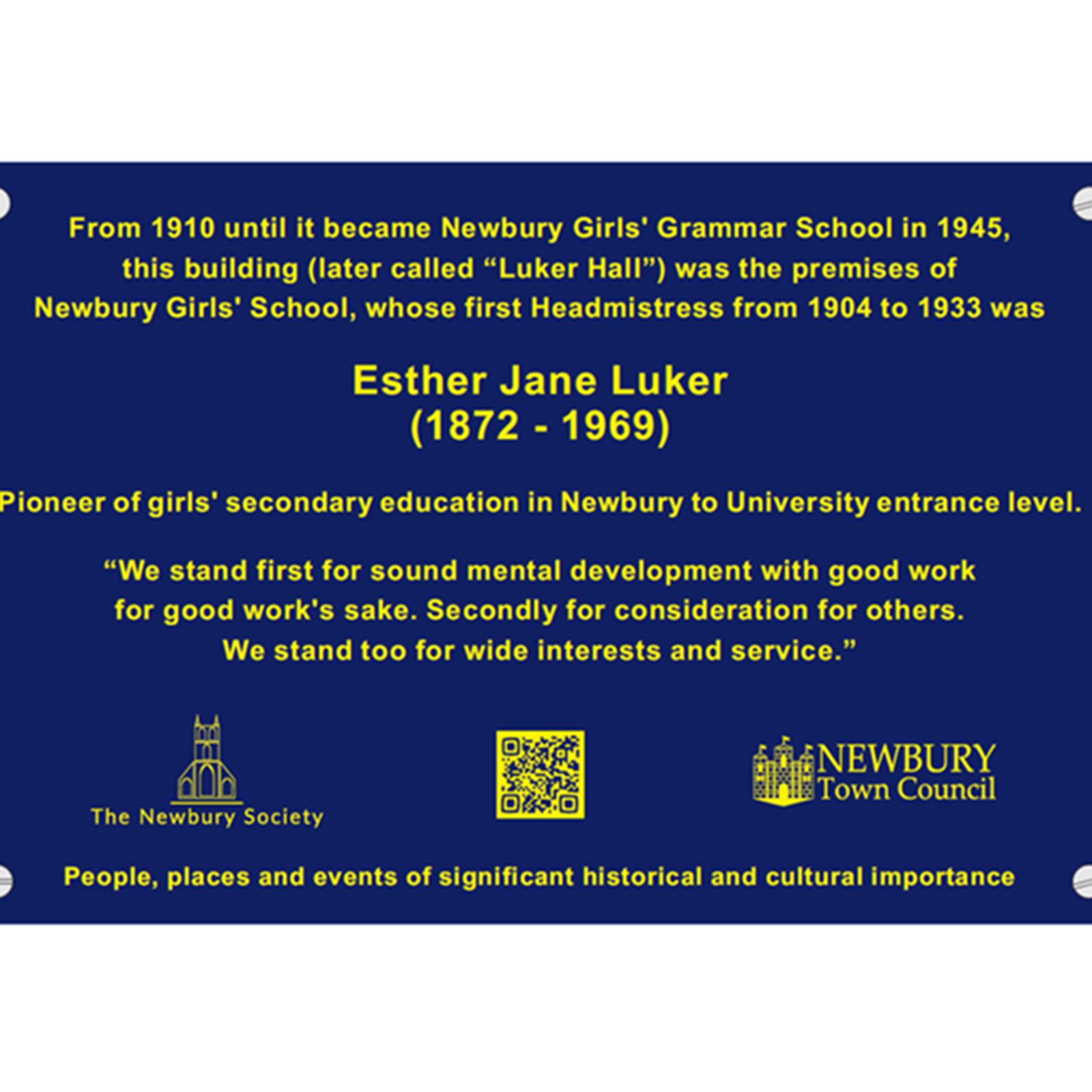
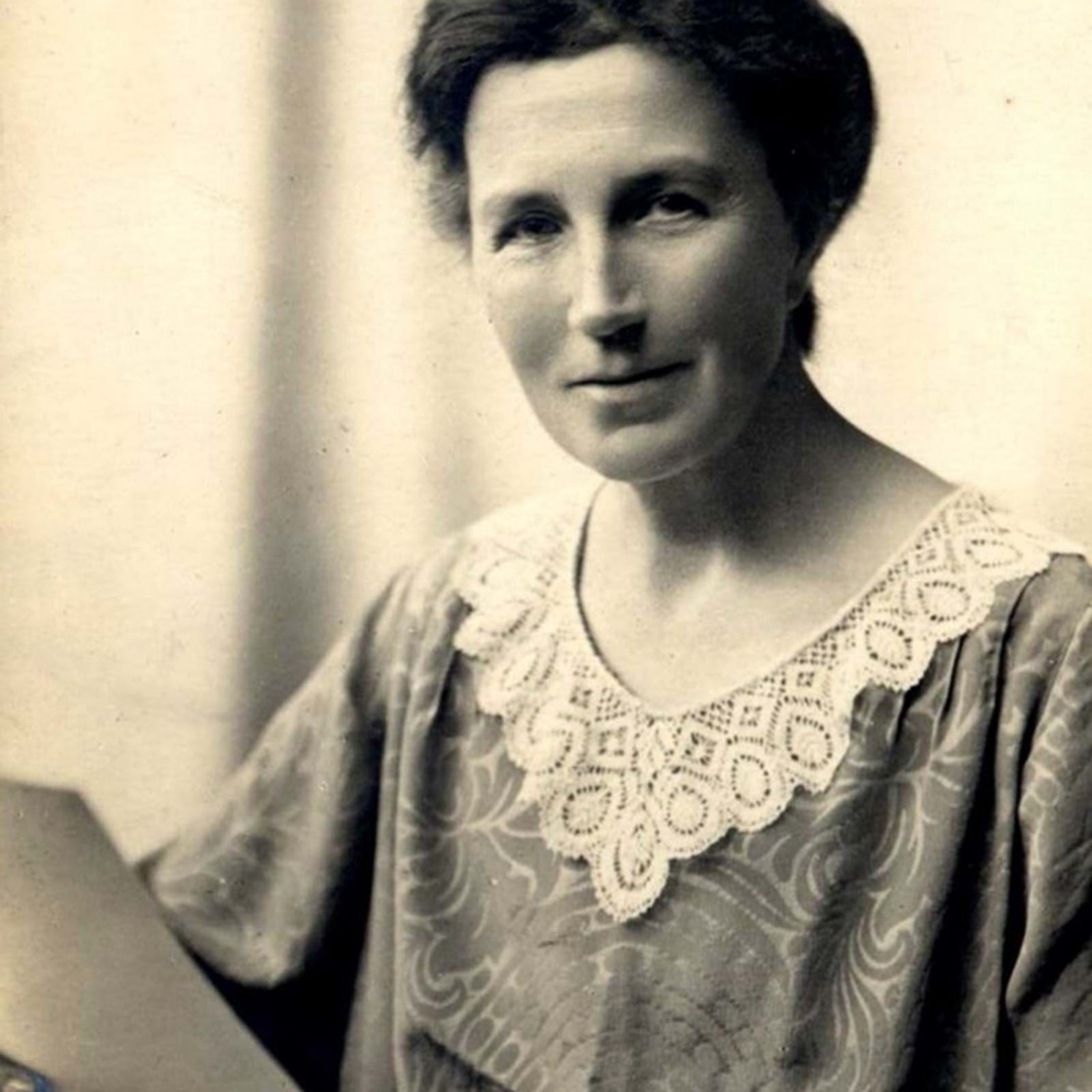
Location: Town Hall, Market Place
James Henry Money was born on October 14, 1834, at the Dene, Oxford Road, Donnington (also known as Donnington Dene), near the Castle pub. He was the son of John and Maria Money; he had two older sisters, and was the second of three brothers. His younger brother was Newbury historian Walter Money.
His father ran a brickworks at Donnington before moving on to create a surveyor’s and then an architect’s business. His mother’s father was also a surveyor.
On leaving school James H. Money trained as an architect, articled to Cooper & Kent of Gray’s Inn, London. At this time his designs were selected in competitions for cemetery buildings at Watford, Ipswich and Keighley in Yorkshire.
On returning to Newbury, he joined his father’s practice in the 1850s, and had effectively taken over by the end of the 1860s. John Money died in January 1874, but had not been involved in the business for several years before then.
James H. Money had a long and productive career: he was active as an architect for over 50 years, from the 1850s until shortly before the First World War. In 1862 he married Martha Joan Vincent, daughter of Newbury solicitor Frederick Vincent.
In 1864 his office was at 34 Northbrook Street (also home to the printers who established the Newbury Weekly News), and his home was in Enborne Road. Later in the 1860s he acquired buildings in the Broadway, including York House, which became his long-established office. His home moved to The Shrubbery, Oxford Road (now Wessex House, opposite Waitrose).
His designs were numerous, in many different styles. They included cottages, pubs, breweries, shops, schools, chapels, church restorations, and extensions to country houses, almost all in the Newbury area, with more around Andover and a school in Devon.
His most prestigious projects were the town halls in Hungerford and Newbury, the Falkland Memorial, and Oddfellow’s Hall in Newbury. Hungerford Town Hall was built 1870-71; Newbury 1876-81, with an extension in 1909-10; the Falkland Memorial at Wash Common, commemorating the first battle of Newbury in 1843, was unveiled in 1878; and Oddfellows Hall in Craven Road, Newbury was built in 1886.
His wife Martha died in 1893 at The Shrubbery. It was after this that he moved his home to York House in the Broadway (now Thames Court), where his office had been for many years. He died on June 21, 1918 at his home in Newbury. The funeral took place at Shaw Church, and there is a memorial cross to him and his wife in the churchyard. He had at least 10 children (one son and nine daughters surviving in 1918).
David Peacock, July 2017
Further information about James H. Money
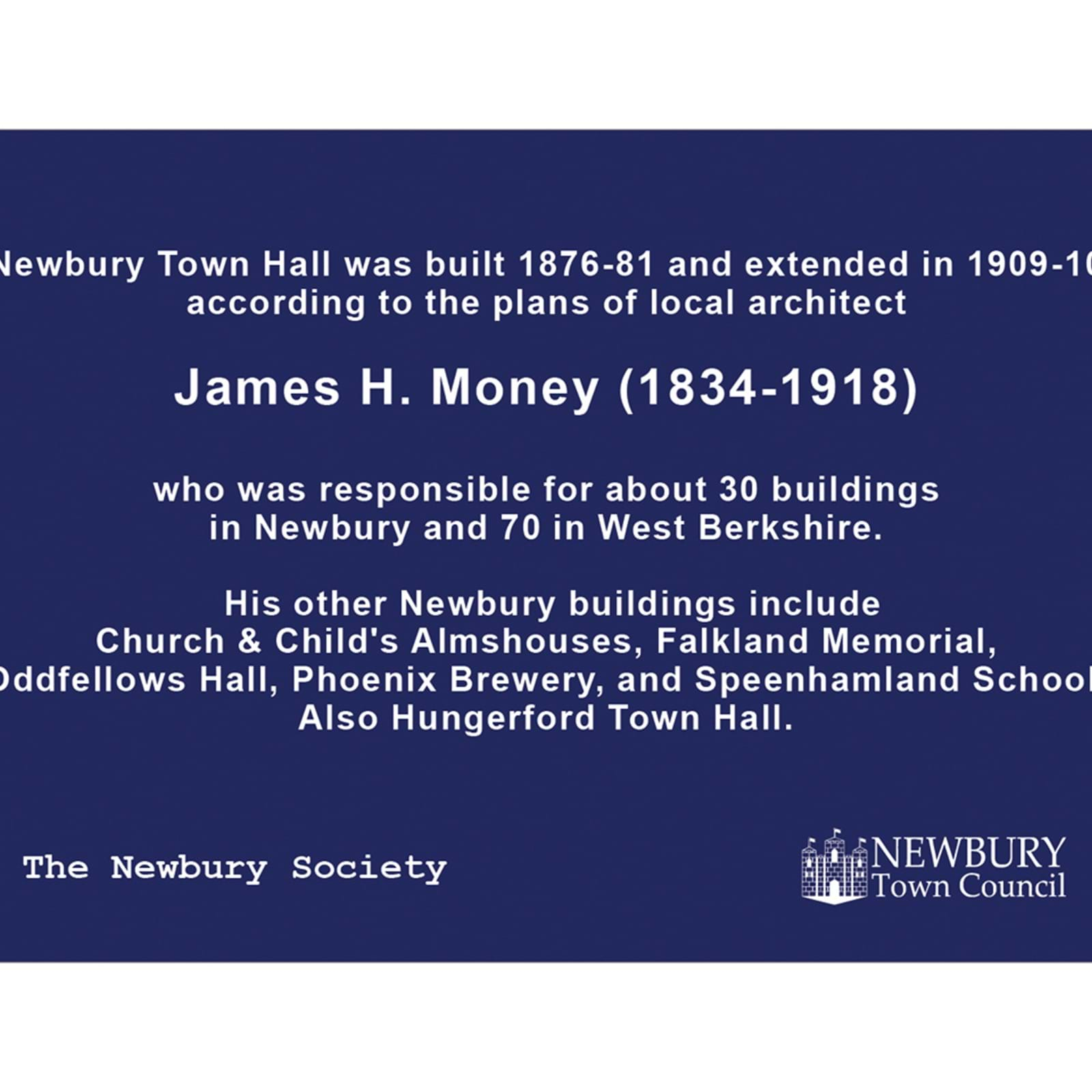
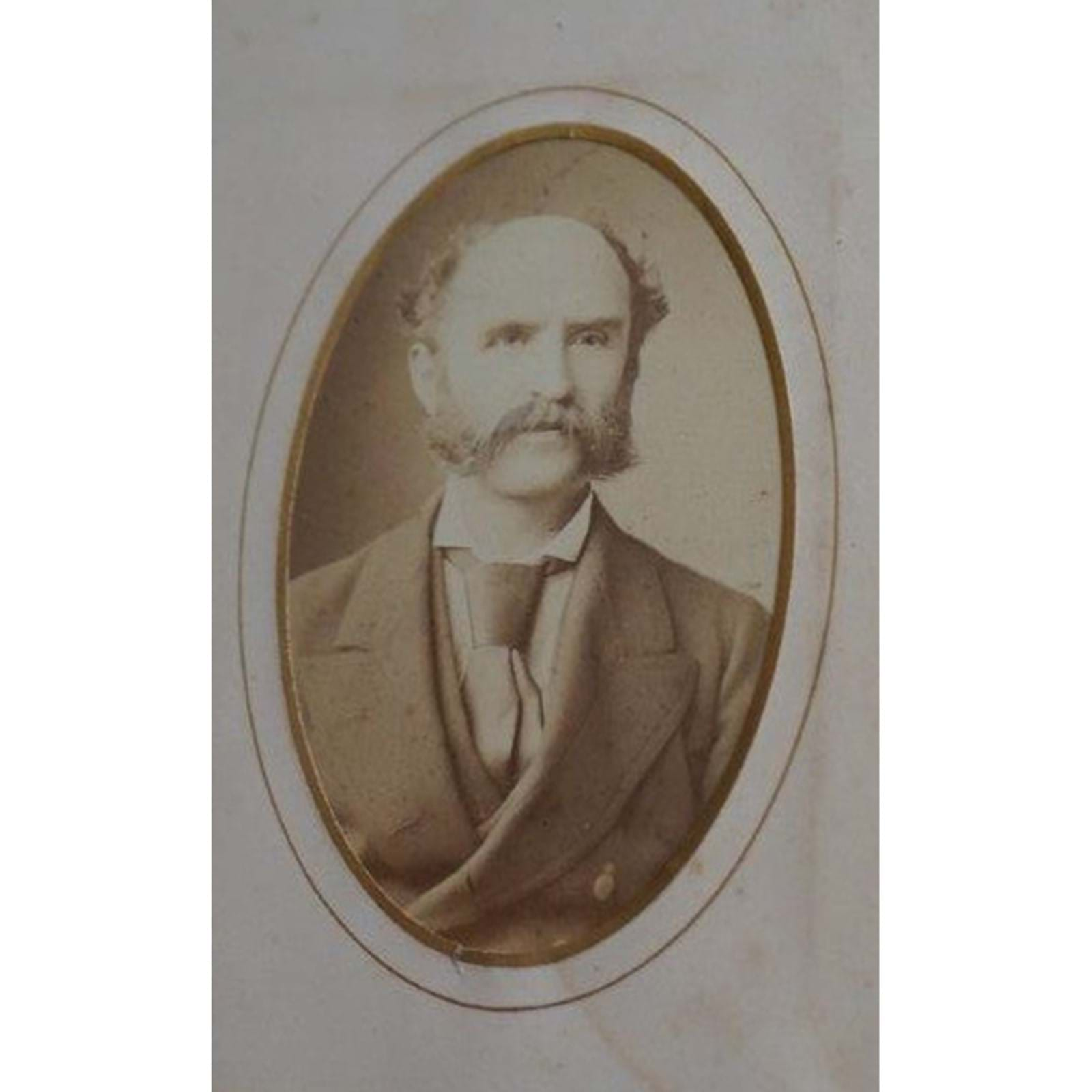
Location: Market Street, at the corner with Bartholomew Street.
Newbury historian Walter Money was born at Donnington Dene, Oxford Road, Donnington in August 1836. He was the son of John and Maria Money, and his brother James H. Money went on to become an important local architect.
As a young man, Walter Money trained as an architect. In 1865 he married Charlotte Ann Butler, and the couple lived for many years at Herborough House in Bartholomew Street. He was there in 18801, still there in 18962, but gone by 19003.
It was while living at Herborough House that he published some of his best-known books, including his monumental History of the ancient Town and Borough of Newbury in the county of Berks, or, more simply, History of Newbury (Parker & Co, Oxford 1887); and The First and Second Battles of Newbury and the Siege of Donnington Castle (W. J. Blacket 1881).
Herborough House was at 122-123 Bartholomew Street, in its later years used by Nias, and then demolished as part of the development of the Kennet Centre.
Walter Money joined the Newbury District Field Club in 1875, and became one of its leading members (Hon. Secretary from 1879 to 1893). He was a churchwarden of St. Nicolas Church. In 1878 he was elected a member of Newbury Town Council and he was a member of Berkshire County Council from 1889 to 1897. He became a Fellow of the Society of Antiquaries (FSA), and was a member of the Berkshire Archaeological Society, and local secretary for the National Trust.
Apart from the books mentioned above, a condensed Popular History of Newbury followed in 1905, along with several more books, a number of booklets, and a long series of articles for newspapers and periodicals, including many for the Newbury Weekly News.
In retirement, he went to live at Shaw Dene. His wife Charlotte died in 1922. He died on October 18, 1926, aged 90, at a nursing home in St. John’s Road. He was buried in the Newtown Road cemetery. In his memory, Newbury Museum (as it was then) was extended with a new building added to the east side of the Cloth Hall.
1. Walter Money letter of Dec 27, 1880 written from Herborough House. In private collection.
2. Cosburn’s Directory of Newbury 1896 p. 314.
3. Cosburn’s Directory of Newbury 1900 p. 314.
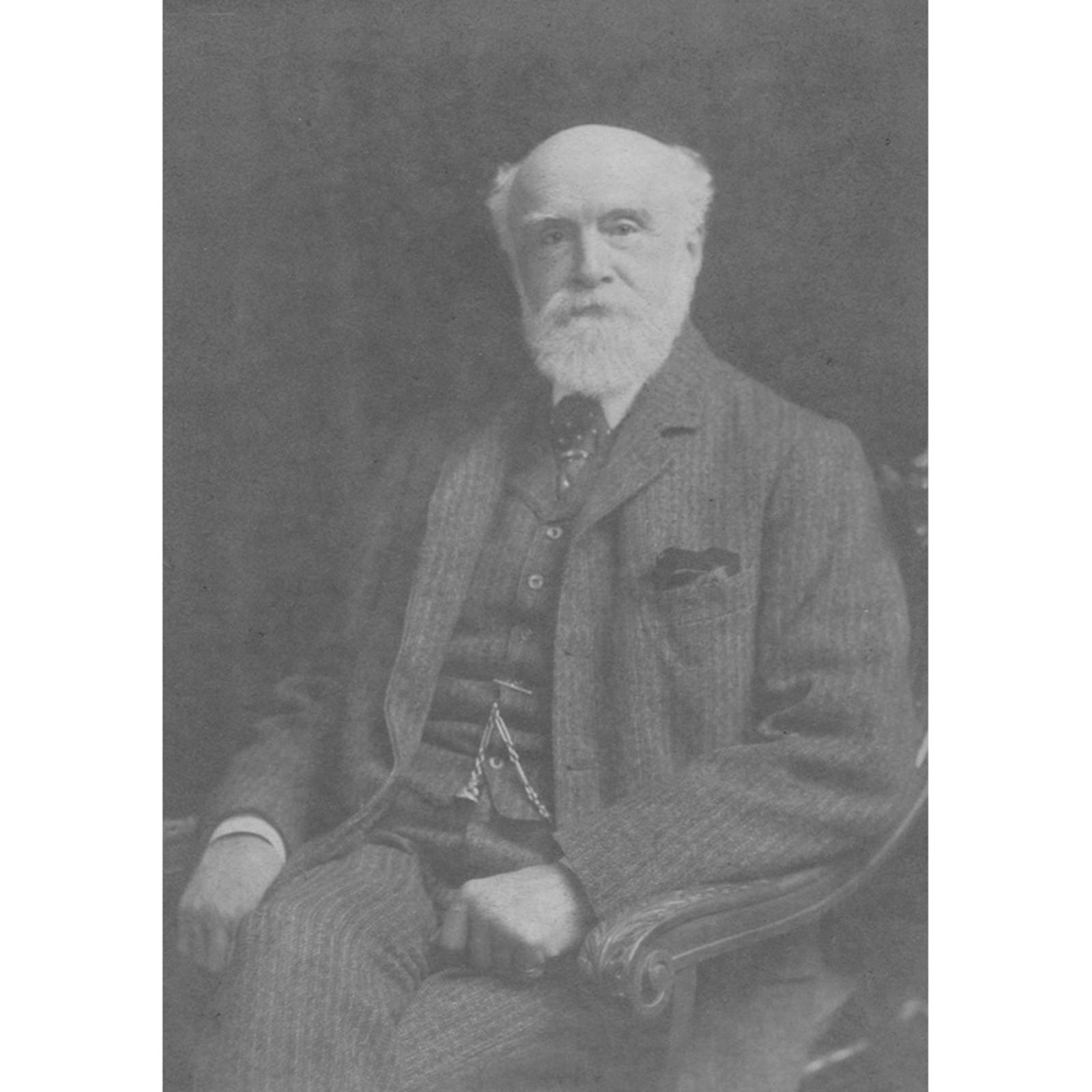
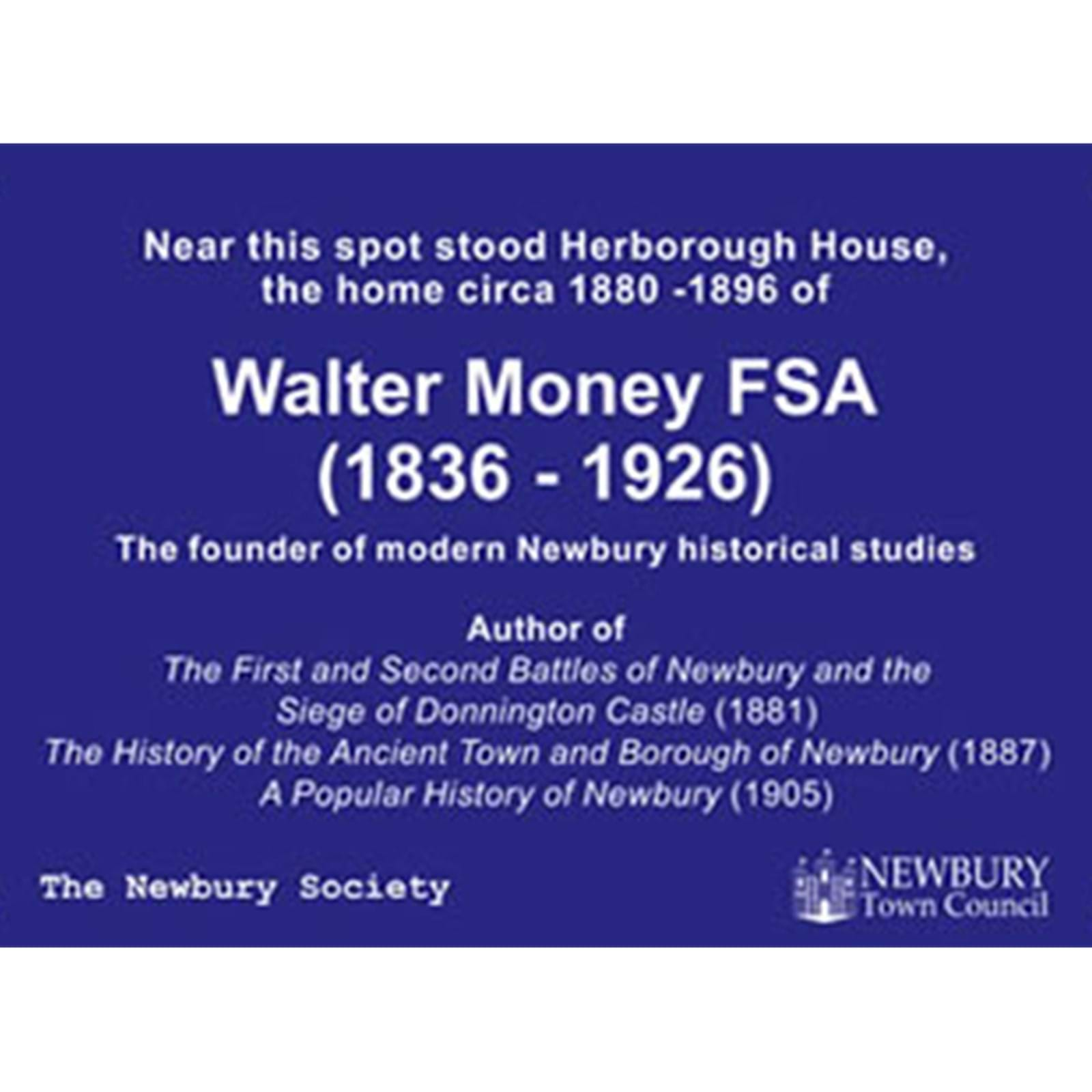
Location: Corner of West Street on Samaritans building
John Newport Langley was born in Newbury, the son of a private schoolmaster, and lived for his early years in West Street, Newbury[i]. He was educated at Exeter Grammar School where his uncle Rev. Henry Newport[ii] was headmaster, and thence at Cambridge University.
Langley succeeded Michael Foster as Professor of Physiology in 1903 and in this role he oversaw the move of the Physiological Laboratory to the present building in 1914, which was provided by the generosity of the Drapers Company. He had first come up to St John’s College Cambridge in 1871 and, on changing his subject to Natural Sciences in his second year, was taught by Foster. Langley became a Fellow of Trinity College in 1877, became a Fellow of the Royal Society in 1883 and held a lectureship in Cambridge from 1884.
Langley championed two major areas of research; following on from Walter Gaskell’s work, he near-single-handedly established the physiology of the autonomic nervous system, the branch of the peripheral nervous system that controls internal organs and glands, including the well-known sympathetic “fight or flight” response. He was also the first person (in 1905) to use the term “receptive substances” to describe receptor proteins in the cell membrane that respond to external chemical signals such as hormones and neurotransmitters; from this he developed a theory of drug action. It is on this basis that much of modern pharmacology and pharmaceutical drug development depends. It would be another 70 years before such proteins were isolated from cell membranes.
During the First World War, he studied nerve regeneration. In addition, Langley took over from Foster the editorship of the Journal of Physiology and steered it into financial stability.
2nd February 2023
[Information from Professors Sarah Bray and Bill Colledge, Joint Heads of Department,
Department of Physiology, Development and Neuroscience, University of Cambridge]
Other sources
Wikipedia and ODNB articles.
Andreas-Holger Maehle“Receptive Substances”: John Newport Langley (1852–1925) and his Path to a Receptor Theory of Drug Action (Medical History, 2004).
Andreas-Holger Maehle A binding question: the evolution of the receptor concept (Endeavour, 2009).
- R. Garrett Changing attitudes on salivary secretion - a short history on spit (proceedings of the Royal Society of Medicine, 1975).
W.M. Fletcher John Newport Langley, In Memoriam (Journal of Physiology).
- D. Nozdrachev, State University, St. Petersburg John Newport Langley and His Construction of the Autonomic (Vegetative) Nervous System (Journal of Evolutionary Biochemistry and Physiology, Vol. 38, No. 5, 2002).
J and J A Venn Alumni Cantabrigienses Langley, John Newport
[i] The address was 1 Carnarvon Terrace, West Street, renamed 50 West Street in 1925 and demolished in the 1960’s. (Source Roy Tubb, Newbury Road by Road (2011), pp. 290-1).
[ii] Rev. Henry Newport was Headmaster of Exeter Grammar School 1852-76. He had previously (1848-52) been the first Headmaster of St Bartholomew’s School, Newbury, after its re-foundation in 1848. John Newport Langley was the son of John Langley and Mary Langley née Groom, the sister of Elizabeth Newport née Groom, the wife of Rev. Henry Newport.
[1] The address was 1 Carnarvon Terrace, West Street, renamed 50 West Street in 1925 and demolished in the 1960’s. (Source Roy Tubb, Newbury Road by Road (2011), pp. 290-1).
[1] Rev. Henry Newport was Headmaster of Exeter Grammar School 1852-76. He had previously (1848-52) been the first Headmaster of St Bartholomew’s School, Newbury, after its re-foundation in 1848. John Newport Langley was the son of John Langley and Mary Langley née Groom, the sister of Elizabeth Newport née Groom, the wife of Rev. Henry Newport.
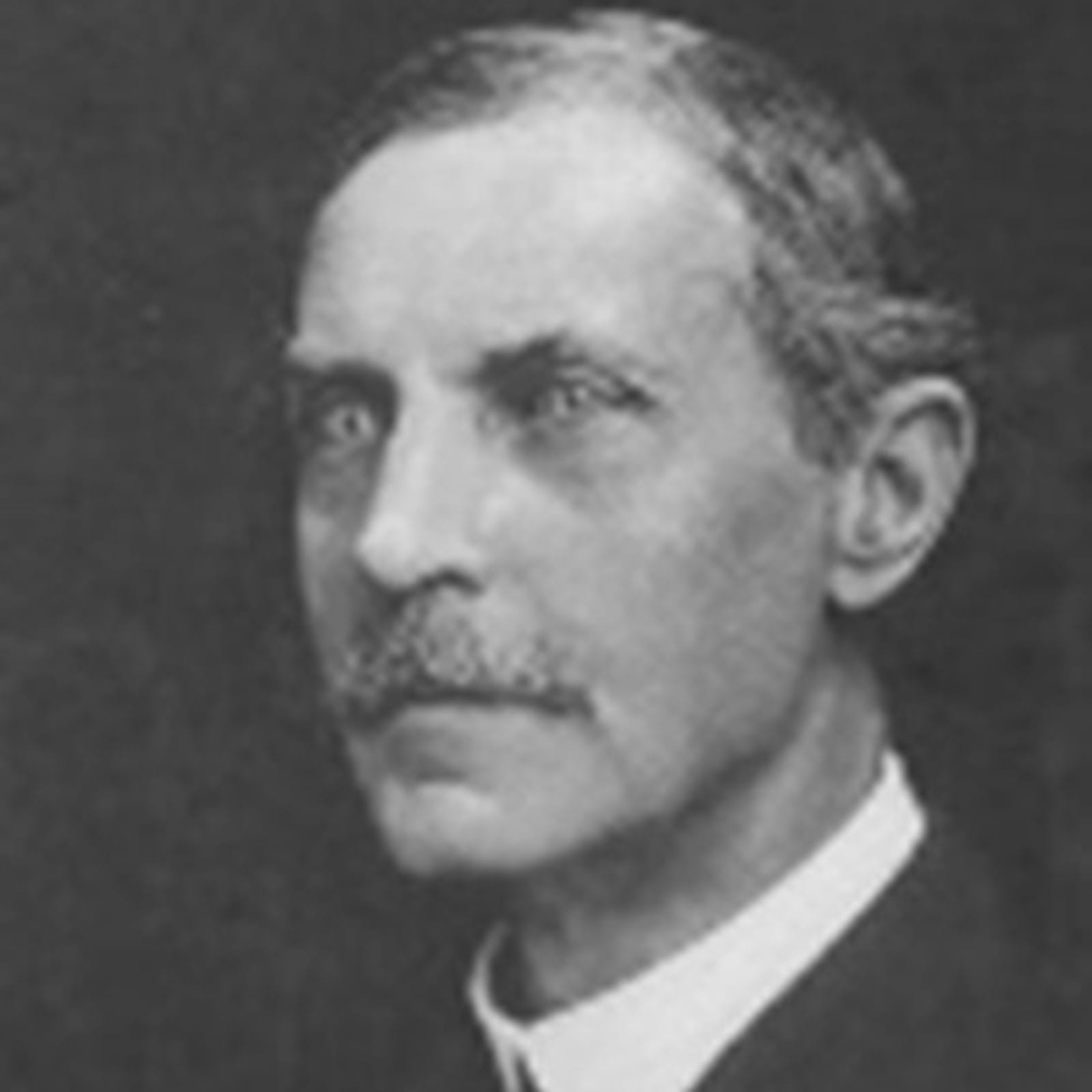
Doris Page was a lady of almost unbelievable determination, who literally without being able to lift a finger, nevertheless with quiet determination and the love and support of her husband and family, changed the landscape for disabled people across the country, inspired and influenced many with her courage and the clear and direct words of her journalism, and showed that the most devastating diseases are no match for the human spirit. She did all this from inside her iron lung in a room at 39, Essex Street, Newbury. As one of the town’s most resolute and indomitable citizens and despite her own almost unbelievable limitations, she thought only of making things better for others.
Doris Page (née Hayward) was born in Walthamstow on 17th November 1925, the daughter of a dray horse keeper, and attended primary and secondary schools in the borough until the outbreak of the Second World War caused her school to be evacuated to Luton. Family circumstances caused her to return home during the early years of the war, and as a teenager she joined and trained with the Red Cross. As soon as she was able, she signed up for military service with the Women’s Royal Naval Service, was posted to the Mediterranean Fleet and worked in signals. During her naval service Doris met Ken, her future husband. Returning to the UK after the war, they married, initially settling in Whetstone, North London. With the arrival of two young sons (Brian and Andrew) and concerned about the severe pollution and fogs of post war London, they sought a healthier life. Ken took a local government job in Berkshire and they moved to 39 Essex Street, Newbury, in the early 1950s.
At first, things seemed idyllic but in late 1955, Doris was taken ill at home and was quickly admitted to the isolation hospital at Prospect Park in Reading, having contracted the respiratory form of polio – a now eradicated virus which paralyses the patient and effectively stops them being able to breathe. The only viable medical response at the time was to place the patient in an ‘iron lung’ – a sealed metal container from which only the head protrudes, with a pump to inflate and deflate the occupant’s lungs, thereby ‘breathing’ for them.
Now imprisoned in her metal cylinder with all the associated machinery, and while in a specialist hospital, with only a tenuous chance of survival and none at all of returning to her home and family, Doris became a founder member and tireless campaigner for the charity “Invalids at Home” (now “Independence at Home “) and set about trying to change some of the archaic restrictions and physical limitations which prevented severely incapacitated people from any sort of home life.
In the 1960s, there was growing interest in human space travel, and the stories of “cosmonauts” who relied on small metal machines to help them breath and survive in space inspired Doris to found a magazine she called ‘The Responaut’, to champion the rights and raise the predicaments of people in a similar position to herself. At this time, there was no disability living allowance, no mobility allowance or even invalidity benefit for “housewives” who could not leave home. With the support of John Astor, then MP for Newbury, Doris began a lifetime of campaigning for change. Such was the strength of Doris’s will that with the support of her husband Ken, by 1957 sufficient progress and adaptation had made it feasible for her to come back to Newbury in her lung with all the associated “round the clock” care requirements to be provided in her family home.
Not satisfied with such a momentous achievement, Doris then undertook a postal learning course in journalism and began writing on disabled issues under the pen-name of Ann Armstrong. There are several theories about this choice of pen-name. Neil Armstrong was of course the first man to walk on the moon. Doris also had links with the Scottish Armstrong clan (whose motto is I remain unvanquished with the symbol of a strong arm). Doris was also photographed by Antony Armstrong Jones (Lord Snowdon) for a number of publications – he had suffered mild polio as a teenager, and it seems they developed some affinity as a result.
Doris / Ann edited the Responaut from 1963 to 1988 and wrote extensively in medical journals, national and local papers and publications such as The Lady and The Church Times. She was a regular columnist for the Reading Evening Post. She was closely involved with many other campaign groups such as the Disabled Income Group and the Union of the Physically Impaired Against Segregation – and the fact that the need for such organisations now seems almost barbaric is strong testament to the effectiveness of her journalistic power.
In 1968 Doris was awarded an MBE – which necessitated loading her bed and equipment into a large truck for the journey to Buckingham Palace. One of the family’s abiding memories is the deep ruts the wheels of the heavy bed and iron lung made in the lush pile of the palace carpets!
Doris wrote two books about her experience and the devastation of polio – ‘Patient’s Prospect’ and ‘Breath of Life’ – which BBC Woman’s Hours serialised in 1982.
After her fight to return home in 1957, there was clearly a huge logistical back up to enable the family to continue with work and school etc. In addition to those involved with Doris’s direct medical care, there were numerous people in the local community who were proud and pleased to help with everything from childcare to shopping – and even the emergency call to pump the lung in the event of a power cut!
Doris/Ann died on 28th August 1991 and her ashes and those of her husband Ken are interred at St George’s Church, Wash Common. Her memorial tablet bears the words “The First Responaut”.
Dave Stubbs
2021
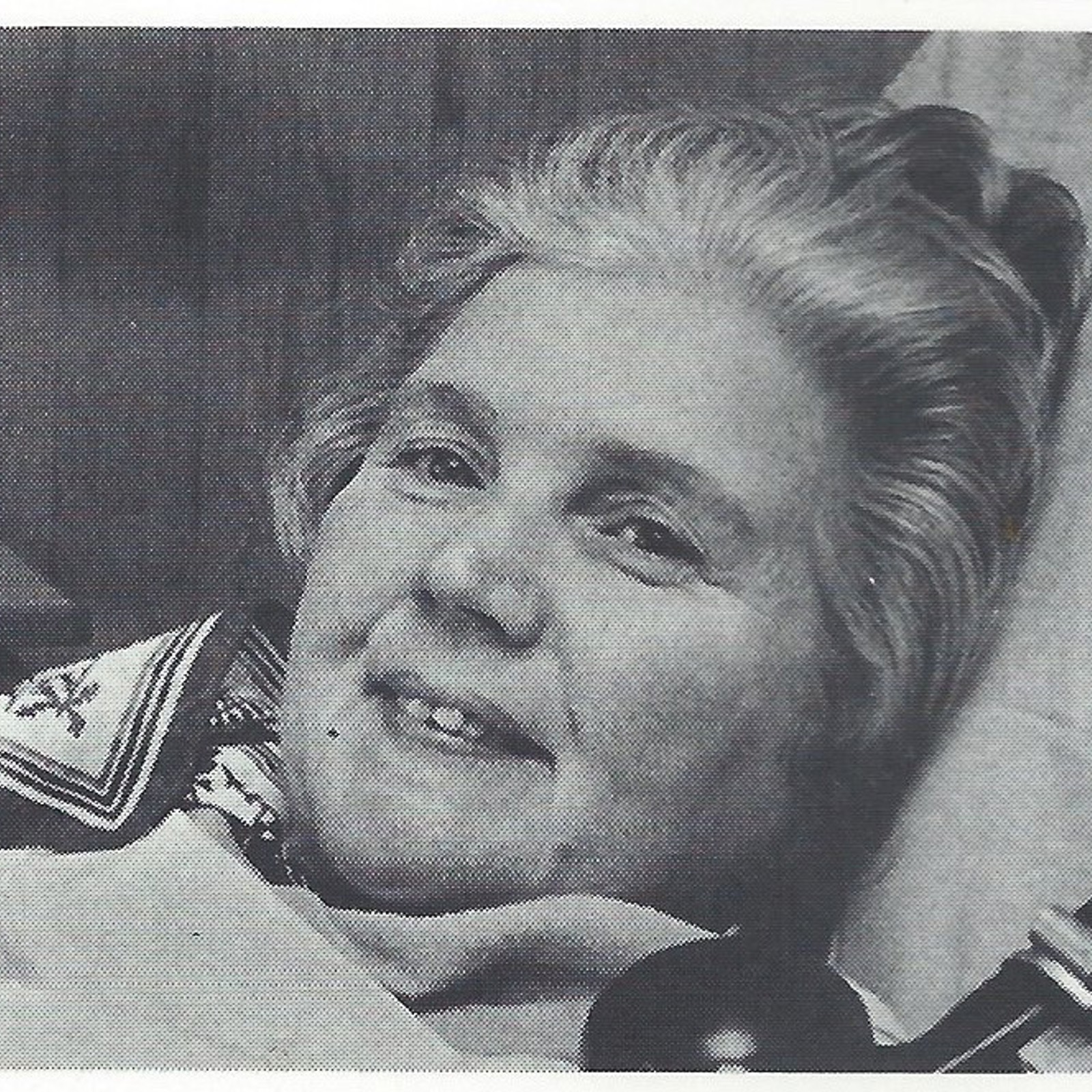
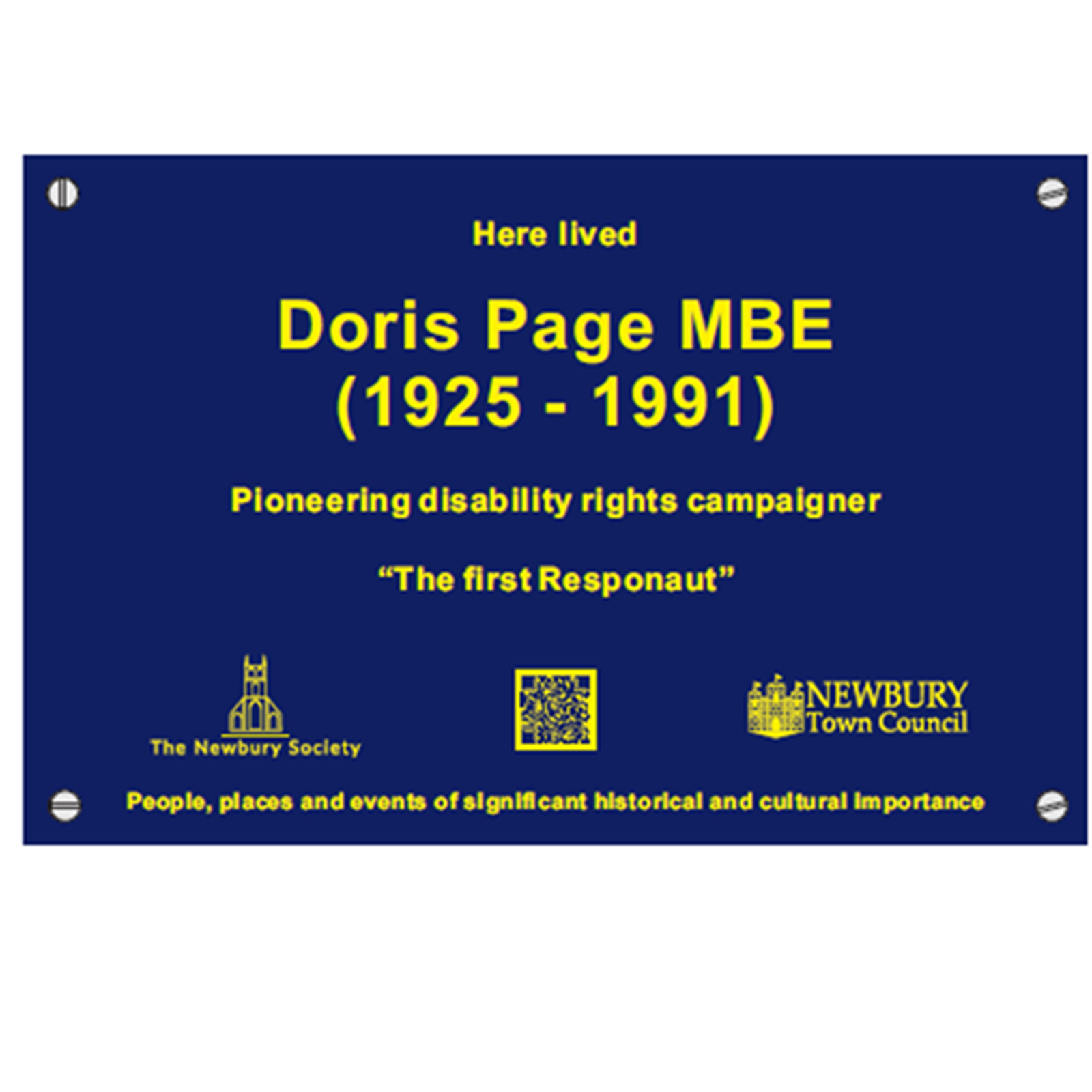
Location: 58 Northbrook Street
Stewart Rome was a British film actor who achieved national fame during the silent film era and successfully made the transition to talkies. He was born and brought up in Newbury and eventually retired here. His versatile and prolific career is credited with over 160 films.
He was born Septimus William Ryott, the son of an auctioneer of the same name who died aged 40 and who was the son of Robert Ryott, a Newbury pharmacist who served as Mayor of Newbury in 1869 and 1870. Septimus Jr was brought up by his mother Alma and educated at St Bart’s. He trained as an engineer, but in 1907 commenced an acting career in Australia. His film debut on his return to England occurred with the Hepworth Film Company and the film “Justice” in 1914. He assumed the professional name “Stewart Rome”. He proved an immediate success, making several films a year, and in 1915 a poll of cinema goers voted him Britain’s most popular film actor. He also served in World War I in the Second Oxon and Bucks Regiment.
The following account of his early life was given in an interview with the Newbury Weekly News on 18 August 1921:
‘“I am the only actor of the family, the others are all interested in engineering or farming. They tried to make an engineer of me, but I could not tie myself down to anything so prosaic. I belonged to a Dramatic Club in Newbury, and I’m afraid that I thought more of my small efforts than of swotting for the exams I should have passed, but didn’t. After a while, we fought out the question of my profession, my parents and I, and I won. I started my stage career in musical comedy, didn’t like it, and was glad to on tour in more dramatic work”
He travelled with a repertory company in the East, returned to England, had a breakdown, and emigrated to Australia; went in for stock farming and came out penniless. Roughed it in the Bush, was a waiter in Perth and a stock hand at Sydney, came back home, tool up film work, and made good. Now he’s a star.’
According to his obituary in the Newbury Weekly News (4th March 1965), he was the first real star of the British cinema. His characters included amongst others a tramp, explorer, Harley Street doctor, prize fighter, race horse owner, clergyman, and fisherman. His film “Comin’ Thro’ The Rye” (1916) was the first to be given a Royal Command Performance.
Bryony Dixon, Curator of Silent Film at the BFI National Archive, states: “Stewart Rome was an important star of British film in the silent and early sound eras. He made more than 160 films between 1914 and 1948 – specialising in debonair rogues and military types – he also played many leading man roles. My personal favourite is his character in The Ware Case (1928), an adaptation of a successful country house mystery play, where he is called upon to have a nervous breakdown on camera. Over thirty film productions featuring Rome survive at the BFI National Archive. Later in his career he played character roles – judges and generals but always in England. Unlike many of his contemporaries he didn’t leave Berkshire for Hollywood.”
His success continued as a freelance after World War I, with films in Germany as well as in Britain. The transition to talking films in 1929 saw him mainly portrayed in fine gentlemanly roles in the 1930’s and ‘40’s, until his retirement to Newbury in 1950 with the movie “Let’s Have a Murder”.
In the late 1930’s his address was "Rooks Way", Hill Green, Peasemore. His later Newbury address was 317 Andover Road.
The building to which this plaque is attached functioned as a silent film cinema, the Newbury Picture Palace, from 1910 to 1934.

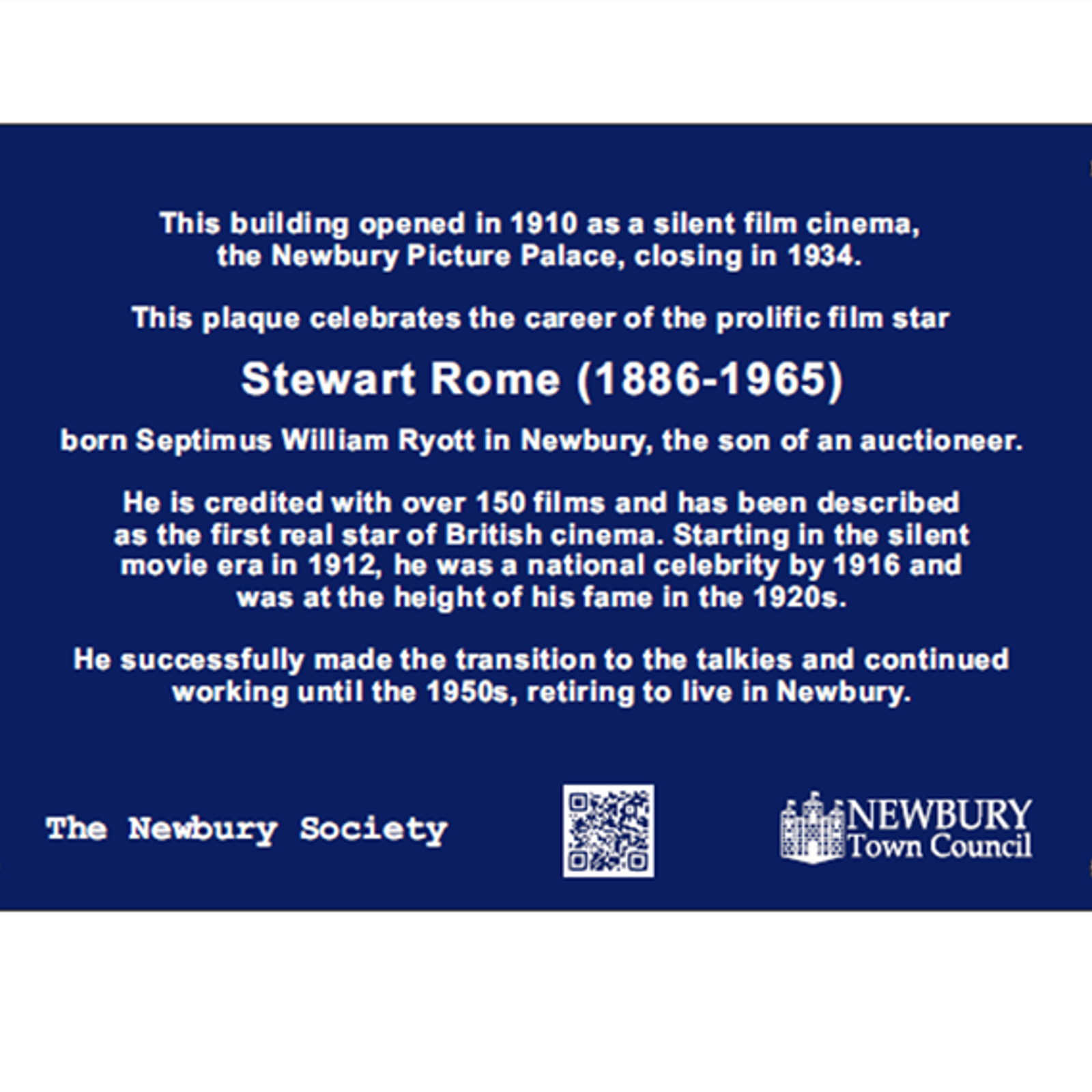
Location: 24 Northbrook Street
“Jack of Newbury” or John Winchcombe II (c.1489-1557) was a leading cloth-producer in the reign of Henry VIII, when woollen cloth was the country’s most important export. For a time, he was the leading figure in England’s leading industry.
The many different cloths produced at the time were dominated by broadcloths and kersies, and current evidence shows Winchcombe producing on an industrial scale: over 6,000 kersey cloths each year in the 1540s. Each cloth was about a yard (0.9m.) wide, and 17-18 yards long. The scale of his production is also indicated by details of the dyeing process. Woad was his most important dye, normally delivered by the cartload. One order survives for 541 cwt, or over 27 tons of woad.
Many people were involved in the production processes, which included spinning and weaving. Fulling took place in local mills and the finished kersies were exported via London to Antwerp, where they were recognised in the 1530s and 1540s as the best of their kind. Although Winchcombe has sometimes been credited with founding England’s first factory, no documentary evidence of a weaving workshop has yet been traced. However, the quantity of cloths produced suggests a workshop of perhaps 30-50 looms.
In the language of the time, he was a “clothier,” organising the production of cloth which was then sold in his name. In the 1530s and 1540s he led a national campaign to persuade Henry VIII to change the law on the making of woollen cloth, heading a group of clothiers from six counties – a campaign which was ultimately successful.
The Newbury area had produced cloth since prehistoric times; and would continue to produce cloth long after Winchcombe’s death. But it was only in his lifetime that Newbury reached national importance in this field. This prominence was real but short-lived.
In Henry VIII’s reign, John Winchcombe combined a role as a cloth-producer with that of one of the county gentry for Berkshire. He was among those present for the reception of Henry VIII’s fourth wife Anne of Cleves, and his personal contacts included Sir Thomas Gresham and the Protector Somerset. He spent over £4,000 on the purchase of property including the manors of Thatcham and Bucklebury, and held a portfolio of other property mainly in and around Newbury. He was a Member of Parliament and a Justice of the Peace.
As one of the county gentry, John Winchcombe led Newbury men to war to fight for Henry VIII, including to the siege of Boulogne in 1544. He was granted a coat of arms, and had his portrait painted in 1550.
His home in Northbrook Street filled the area between Jack Street and Marsh Lane (now mostly occupied by Marks & Spencer, and previously by the Jack Hotel), and here he welcomed the future Protector Somerset. It consisted of timber-framed buildings ranged around courtyards. A fragment of this extensive home survives on the corner of Marsh Lane, complete with carvings and mouldings. Other carvings now at Sudeley Castle in Gloucestershire. It is on this surviving part of his house that the blue plaque has been placed.
A fictionalised story of his life, written by a contemporary of Shakespeare, with published in the 1590s. This was “The Pleasant Historie of John Winchcombe, in his younger years called Jack of Newbury…” by Thomas Deloney. Thomas Fuller described Winchcombe in the 17th century as “…the most considerable Clothier (without fancy or fiction) England ever beheld.” Winchcombe has been frequently confused with his father, who died in 1520 and was also a clothier.
David Peacock 2017
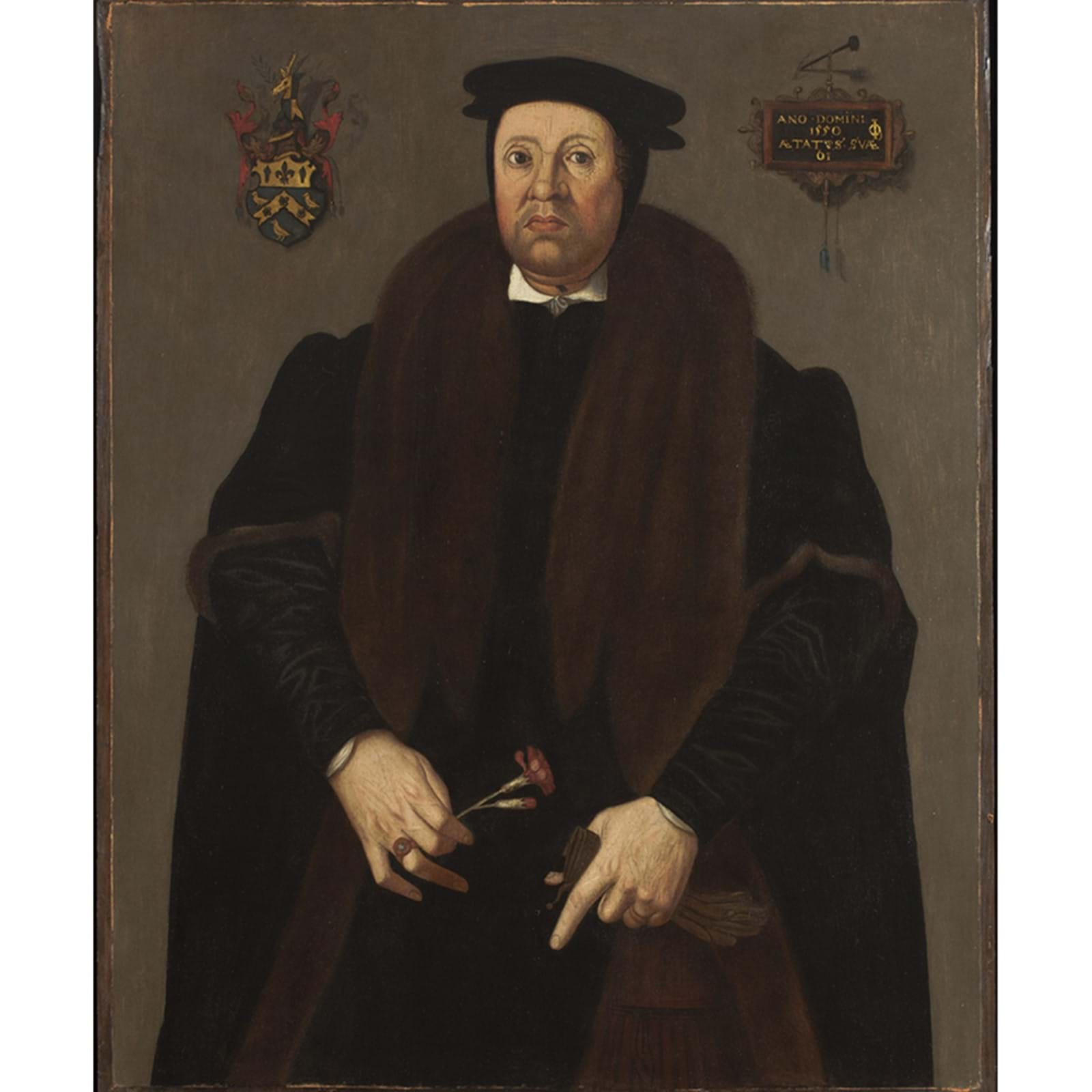
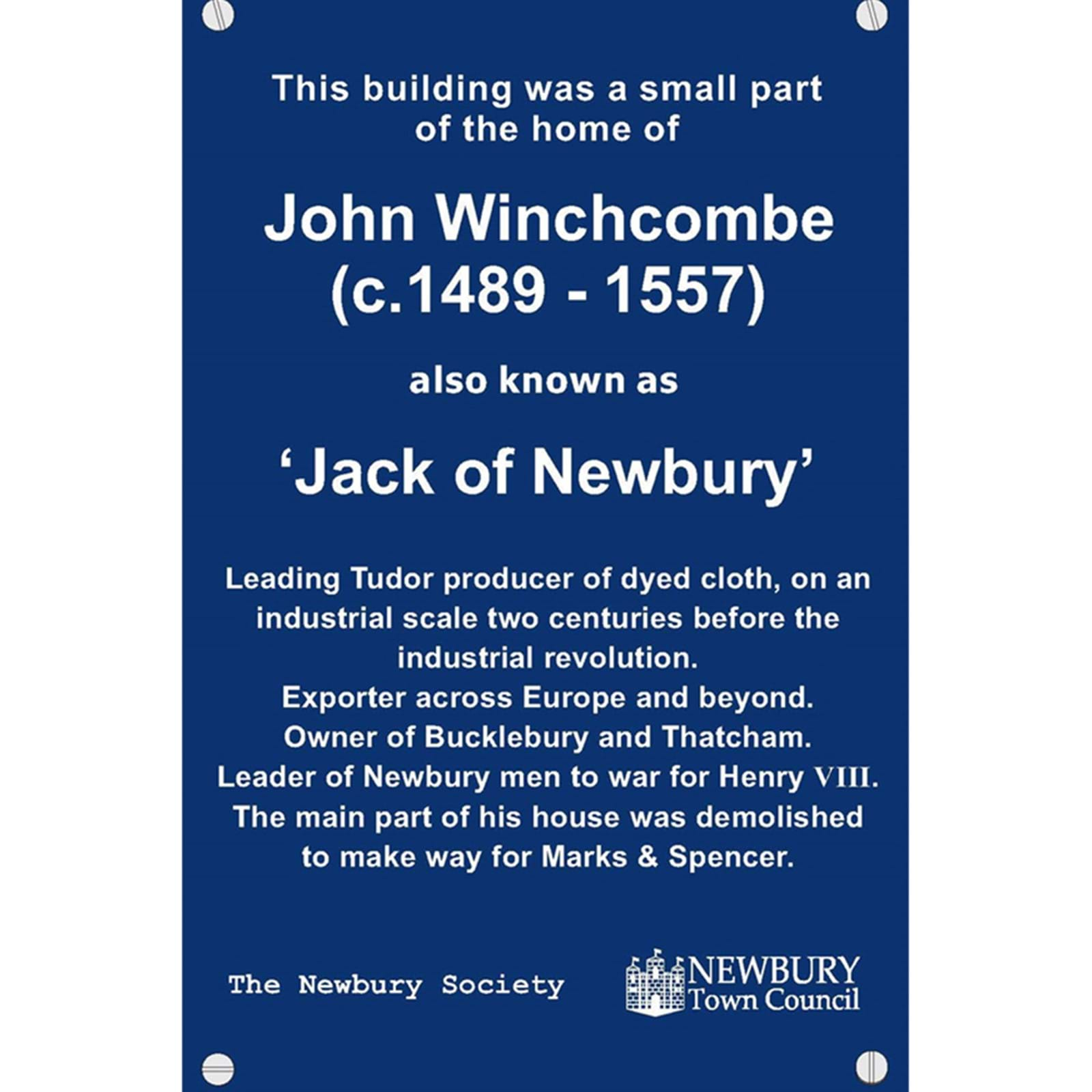
Location: Train Station, Station Road
This plaque commemorates the central role that was performed by the former Didcot, Newbury, and Southampton Railway in conveying service personnel and military materials from the Midlands and the North of England to the Port of Southampton in preparation for the D-Day invasion of Nazi-occupied Europe on 6th June 1944. The plaque is located outside Newbury Railway Station, by kind permission of Network Rail and Great Western Railway.
The DNS Railway constituted the heavy transport link for this vital supply. At its peak, it carried 120 train movements a day. To accommodate the traffic, the line between Didcot and two miles south of Newbury was doubled. Despite its name, it terminated at Winchester, and depended for the final part of its route on other railway lines. Unfortunately, it never proved profitable from its opening in 1882/1885 or after 1945, and was eventually closed in 1964.
Newbury Railway Station was first built in 1847. It was rebuilt as the present building between 1908 and 1910, to handle the traffic through Newbury on the Didcot, Newbury and Southampton Railway, the Great Western Railway, and the Lambourn Valley Railway.
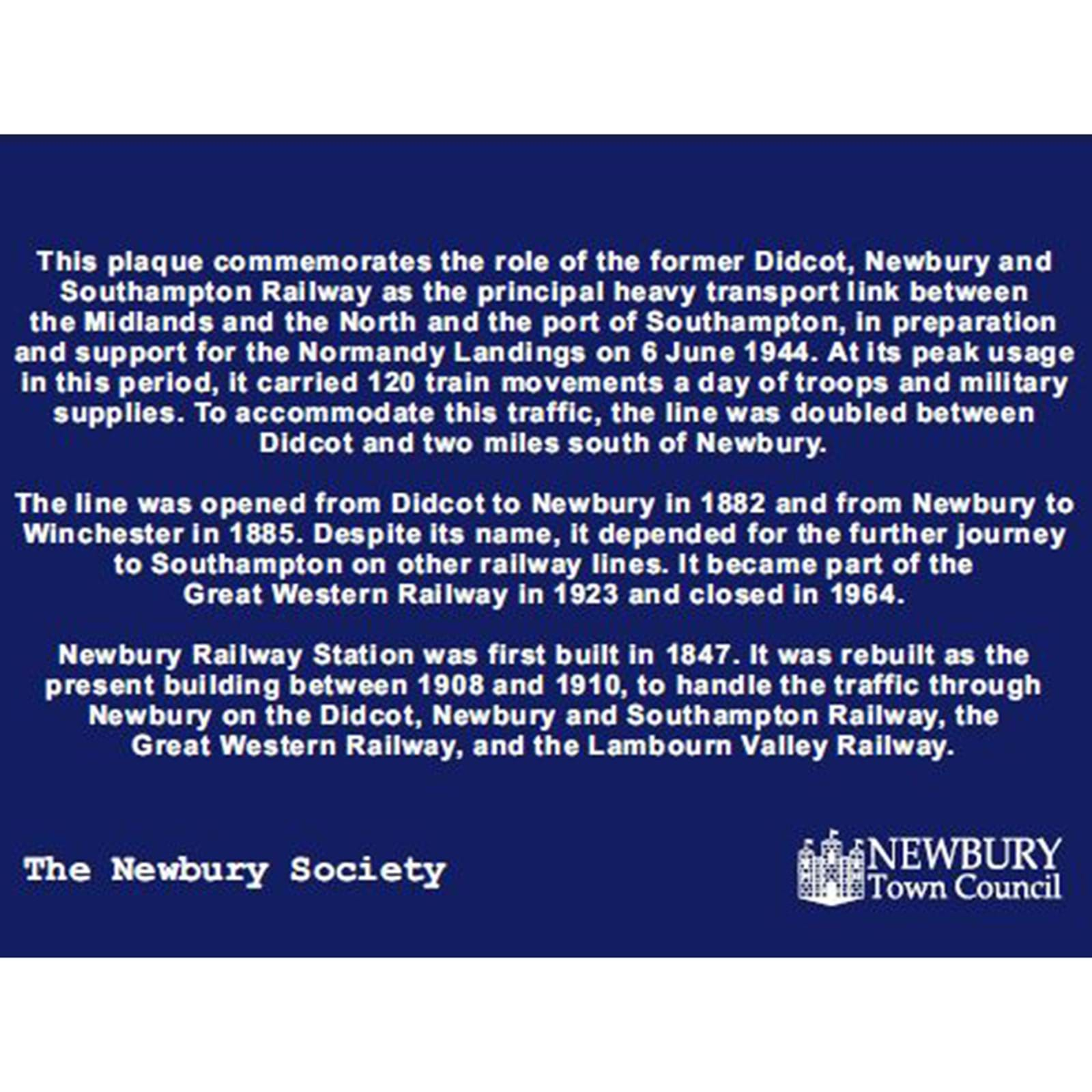
Location: 2 London Road
The George & Pelican was Newbury’s most famous coaching inn. It was created around 1730 by the amalgamation of The George and The Pelican, a few years before the Great Bath Road (the modern A4) was fully ‘turnpiked’ in the 1740s. The creation of turnpike trusts was an early form of privatization in which companies took over the maintenance of major roads in return for the right to charge users a toll to use them. It was a great success and resulted in a massive improvement in the standard of roads, which enabled a new age of travel – the coaching era. The inn was in Speenhamland, which was not then within the Parish or Borough of Newbury, although clearly a part of the overall town.
It was not the grandest inn or hotel in Newbury. It catered for a wider section of the community than the very rich and, as a result, it was a more viable business, whilst seeing its fair share of custom from the highest echelons of society. During its heyday it was visited by many notable travellers, including King George III and Queen Charlotte, Charles Dickens, Samuel Coleridge, William Cobbett and the actor James Quinn - who is credited with the witty epigram:
The famous inn at Speenhamland
That stands below the hill
May well be called the Pelican
From its enormous bill.
In 1795 local MP, Charles Dundas, chaired a meeting of Berkshire JPs at the George & Pelican that decided to address the pressing issue of agricultural poverty through a widely adopted system of relief known as the Speenhamland System (taking its name from the inn’s location).
During the golden age of the coaching era the George & Pelican was owned and run by George & Eleanor Botham and was a large business. They owned over 200 horses which would could be rented by travellers or coaching companies. The inn had stabling for 300 horses, a bowling green and pleasure gardens on the north side of Speenhamland Backway (now part of Pelican Lane) to the rear of the inn. When a Parliamentary select committee was inquiring into the optimum road-making technique George Botham was called to London to give evidence. He spoke in favour of John McAdam’s process, which was later developed into tarmac.
The opening of the Great Western Railway in 1841 heralded the end of the coaching era in this part of the country, the trade shrank immensely, and Eleanor Botham (George had died a few years earlier) went bankrupt. The inn struggled on for a while, eventually closing in 1869 when the final proprietor, Henry Thomson, moved to the Three Tuns (now the Elephant in the Market). The stables then became a livery business that continued trading well into the 20th century.
Phil Wood (2019)
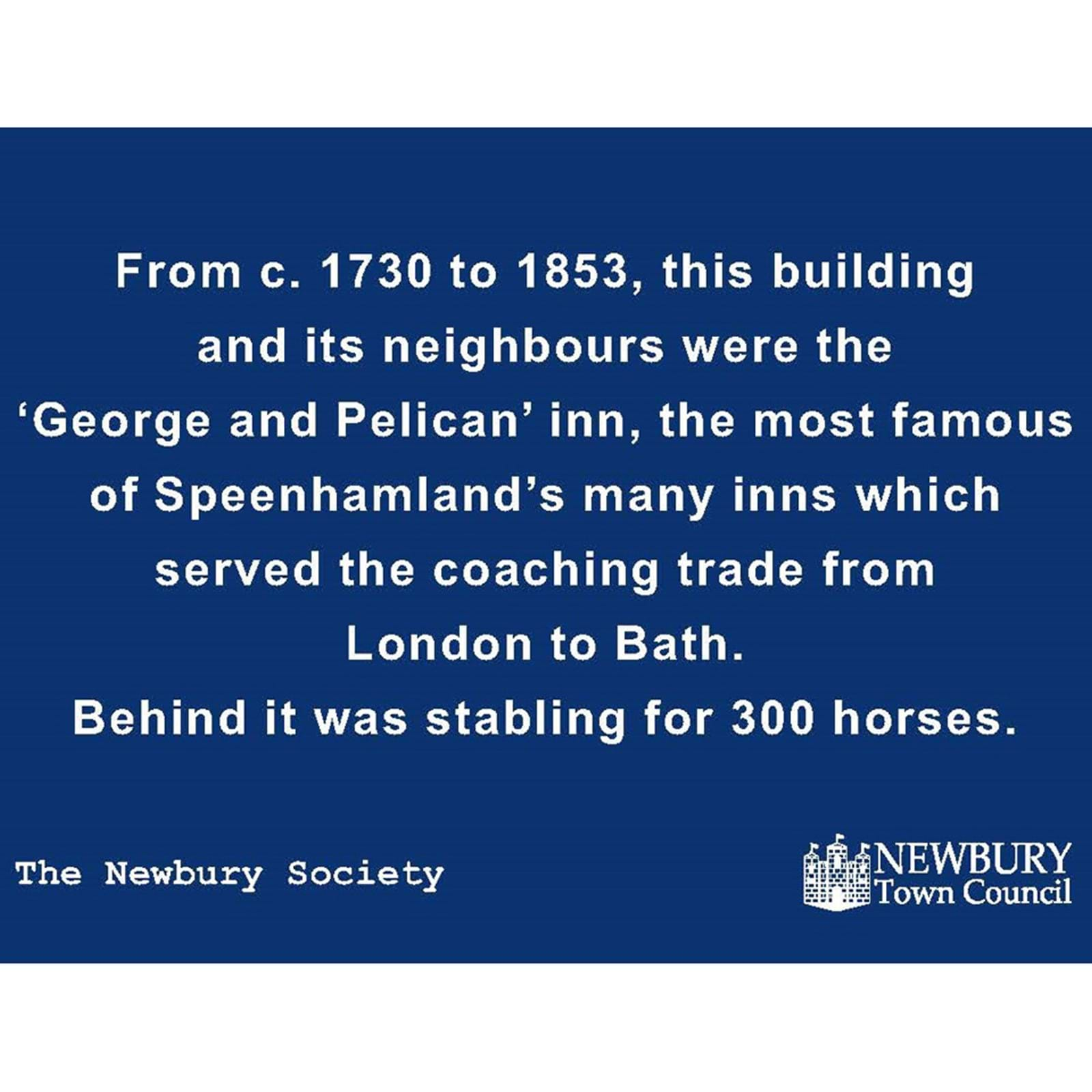
Location: St Nicolas House, West Mills
Brewing on a commercial scale began to establish itself as a major industry in the late middle ages, following the introduction of hops into the brewing process. Hops add bitterness to the brew, but also act as a preservative, meaning that there was more time to transport the beer to retail premises where it had a longer shelf life. However, it would be confined to larger towns and cities until an effective means of distribution was available to enable the brewer to reach a larger market. The first evidence of commercial brewing in Newbury was in 1643, when 34 publicans, and three brewers were amerced (fined) at the manorial court for taking excess profit in beer.
In 1723 the River Kennet was made navigable to Reading, meaning that the country’s largest market for beer, London, was within reach of Newbury. The earliest records of the ‘Navigation’ show that almost immediately at least one Newbury brewer, John Townsend, was shipping beer in bulk to the capital where Newbury beer was soon a popular tipple.
The Beer House Act of 1830 was an attempt by Parliament to break the monopoly of the brewers. The idea was that their grip on the trade, largely gained though the local monopolisation of pub licenses, would be broken by allowing anyone with suitable premises to sell beer or cider, preferably brewed on the premises. However, the brewers soon became the suppliers of the new premises as well as the old and the act failed in its intent. Nevertheless, it was partially successful in increasing competition since numerous new breweries were opened to exploit the increased market. Some of these had short lives but, by the time the Act was repealed in 1869, there were nine commercial breweries in Newbury.
From the 1890s the numbers were diminished through mergers and takeovers from which the South Berkshire Brewery Company in West Mills emerged as the major player. By 1920 there were only four breweries left; in that year the South Berks was purchased by H & G Simonds of Reading, which also bought the Newbury Brewery Company of Northbrook Street in 1930 and Adnams’ Eagle Brewery of Speenhamland in 1936. The takeover of Adnams’ marked the end of brewing in Newbury since the fourth of the last brewers, Finn’s Phoenix Brewery of Bartholomew Street had been acquired by Ushers Brewery from Trowbridge in 1926.
The blue plaque marking the importance of the brewing trade to the town has been placed on St Nicolas House in West Mills. This splendid Grade II* listed building was built in the 1730s as a home for Samuel Slocock, proprietor of the West Mills Brewery.
Phil Wood (2019)
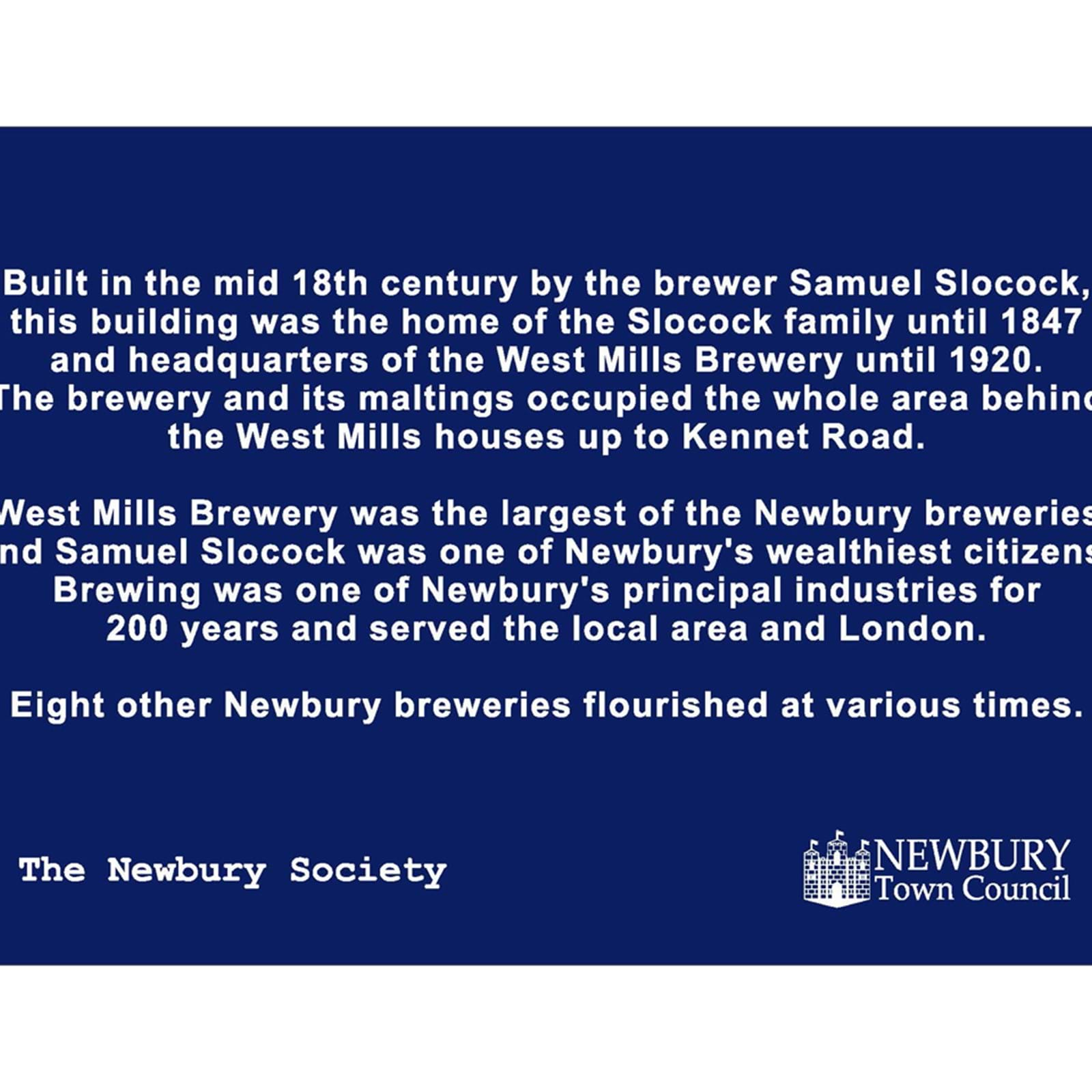
Location: Cheap Street, Newbury
Plenty’s was founded in Southampton in 1790 by William Plenty (1759-1832), a millwright and agricultural engineer, who shortly afterwards moved the business to Cheap Street in Newbury. In 1800 he patented an iron plough, which was recognised as being more manoeuvrable and economical in use. In 1817 he launched a new design of lifeboat, which was exceptionally stable and seaworthy, and was adopted by the body now known as the Royal National Lifeboat Institution. 11 were stationed round the British coast and saved many lives at sea.
William was succeeded in management of the business by his sons James Shergold Plenty (1811-51) and Edward Pellew Plenty I (1816-98) (named after Admiral Sir Edward Pellew). In 1865 they diversified by patenting a marine steam engine, and in 1880 the company was added to the Admiralty list for supply of steam engines, used particularly in Royal Navy picket boats and in submarines from 1885-87. The company supplied marine engines world-wide and in 1890 was incorporated as Plenty & Son Ltd. The premises became known as the Plenty Eagle Iron Works. Subsidiaries were founded in Glasgow, Southampton, and overseas.
Edward Pellew Plenty I was elected Mayor of Newbury in 1865-66. He partially retired in 1868 to “Budd’s Farm” in Burghclere, which he had inherited through his wife Caroline Simmonds, the niece of William Budd, Solicitor and Mayor in 1789-90. He experimented in agricultural improvements and retired fully in 1884. His son Edward Pellew Plenty II had succeeded him, but in 1899 absconded with £4600 of the company’s assets. The other Directors Harry Wethered and the second Earl Russell then appointed Edward Plenty II’s son Edward Pellew Plenty III (1868-1949) (known as Jack Plenty) to head the firm. Jack Plenty had a son Edward Pellew Plenty IV (1897-1921), who achieved a brilliant career in the Royal Flying Corps, being promoted Lieutenant in 1915 and Major in 1918, but very sadly died in the influenza epidemic of 1921. The family’s connection with the firm therefore ended in 1949.
Plenty’s diversified into a wide range of products, including iron bridges, and in 1920’s adopted diesel technology, with engines for not only for ships, winches, and compressors, but also power stations. In 1935 it commenced production of a wide range of rotary pumps. Filters were added in 1951 and mixers in 1955 as it focused on fluid processing products. In recent decades (1970s onwards), some of Plenty's work was in connection with North Sea oil.
In 1965 the company moved from Cheap Street to its present premises in Hambridge Road. In 1969 it was acquired by Booker McConnell and in 2001 by SPX Flow Technology, an international company with $2 billion in annual revenue and operations in 30 countries. SPX Flow Technology’s pumps, mixers, and filtration products for the oil and gas, water, food, and chemical industries bear the Plenty brand.
Anthony Pick
10th October 2019
Sources:
Newbury Advertiser 22-29 September 1987.
Newbury Weekly News 26 February 2015 (for E.P. Plenty IV).
Berkshire Record Office (Ellie Thorne).
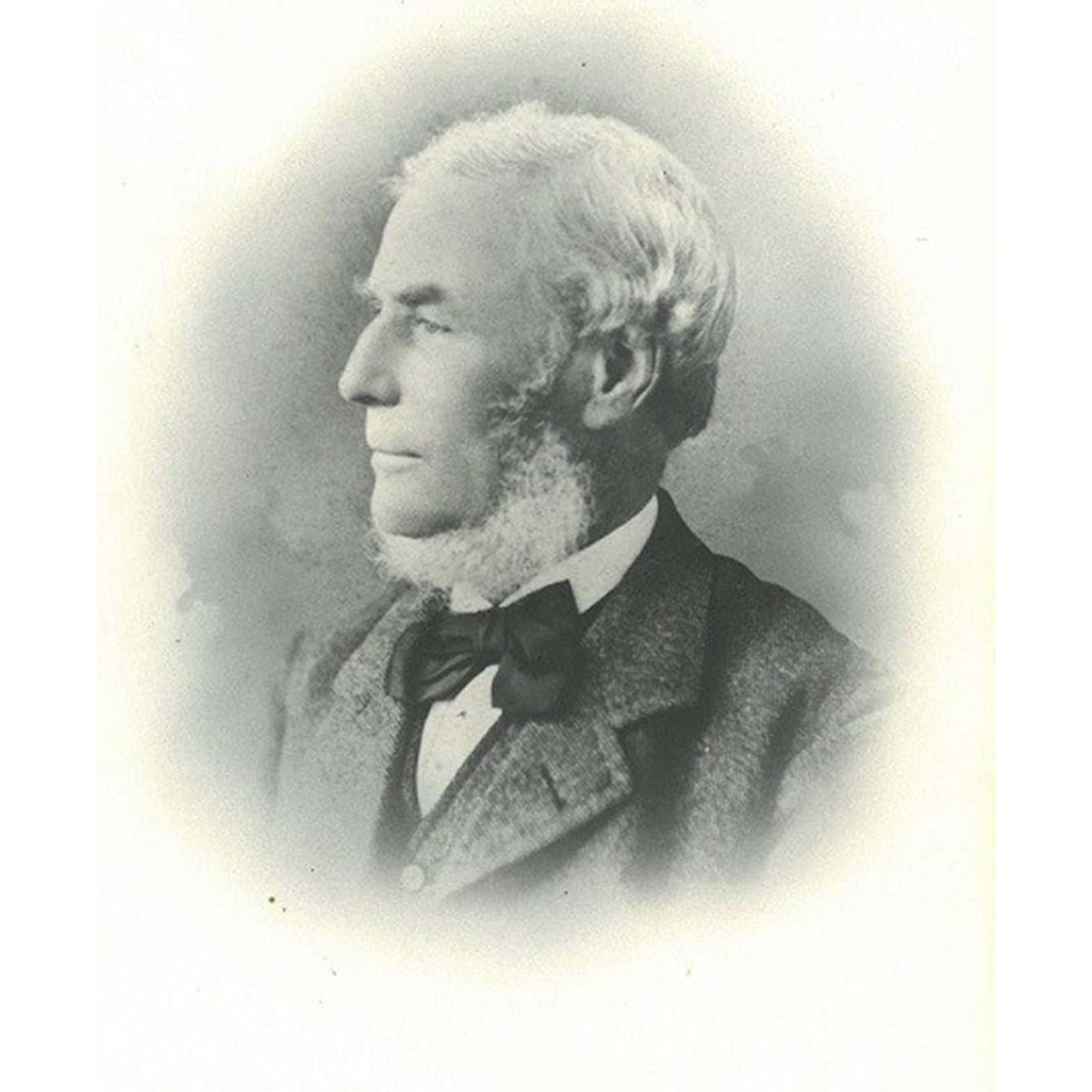
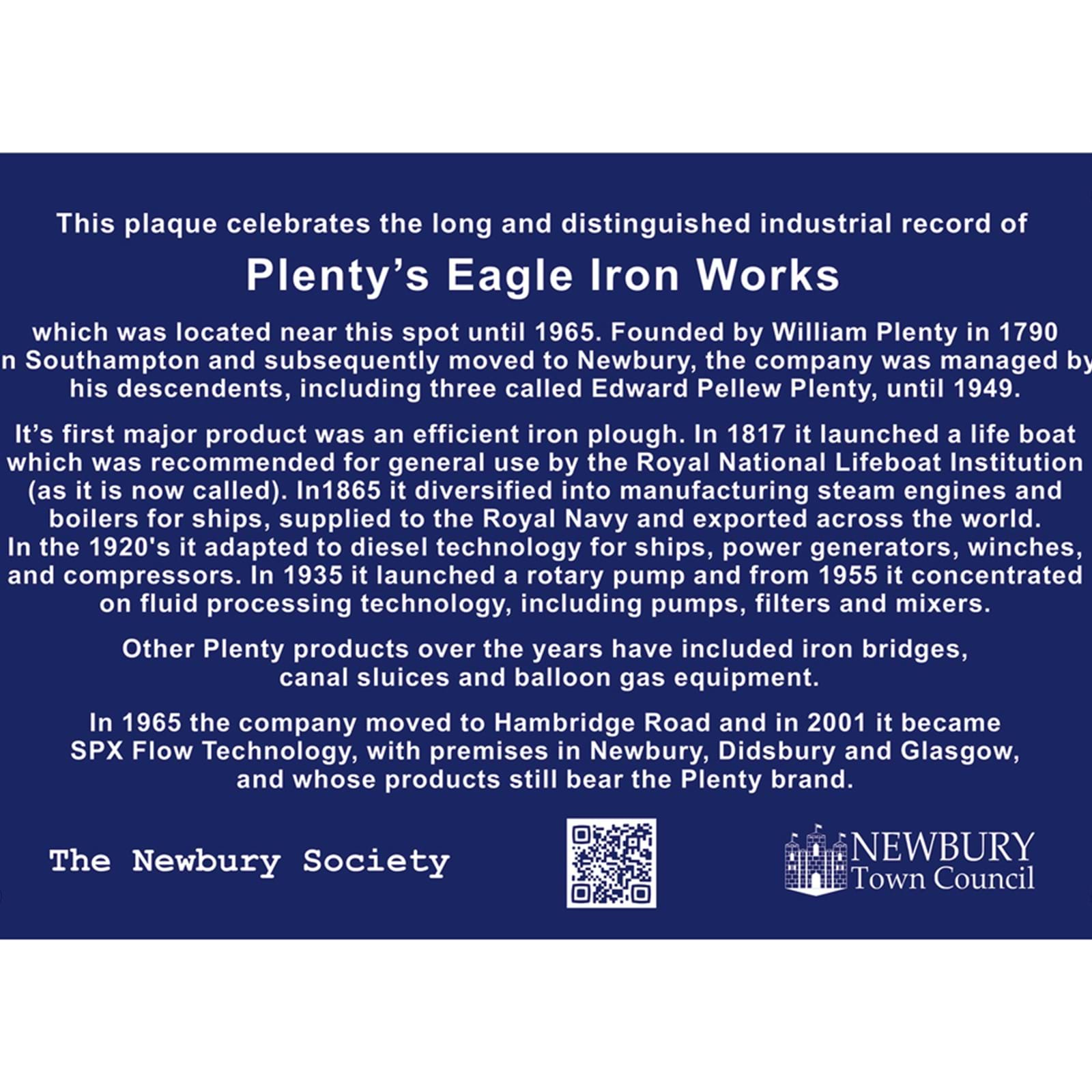
Location: Thames Court, 20-22 The Broadway
Press report dated 3rd January 1985 courtesy of the Newbury Weekly News
Michael Harrison secretly left his family’s 1985 New Year’s Eve party at their home in Surrey in the UK to surprise his father, calling him from London’s Parliament Square. Harrison made the historic call from one of the first mobile devices – a Transportable Vodafone VT1, which weighed 11lb (5kg) and had around 30-minutes of talk time. Harrison recalls that the line was crystal clear, although the excited shouting of New Year’s Eve revellers in London created considerable background noise.
As Sir Ernest Harrison answered the phone, Michael said: “Hi Dad. It’s Mike. This is the first-ever call made on a UK commercial mobile network”. At the other end of the line, champagne corks popped and photographers captured the moment - the culmination of three years of hard work since the bid was made to win the licence in 1982.
Days later, a large crowd gathered at St Katherine’s Dock in London to watch comedian Ernie Wise make the first public mobile phone call. Wise brought the same Transportable device to St Katherine’s Dock in London in a 19th century mail coach, using one of the oldest forms of communications – sending a letter – to highlight the speed and convenience of these new mobile phones. Ernie Wise’s call was received at the original Vodafone headquarters, where a handful of employees were based in an office above an Indian restaurant in Newbury, Berkshire.
Heavy and cumbersome, the first generation of mobile phones were sold in the UK from 1984 – before the first products were even available and before the network was officially live. Such was the demand for a fully portable, cellular phone that more than 2,000 orders had been taken by the Vodafone sales team before Michael Harrison made his call from Parliament Square. By the end of 1985, over 12,000 devices had been sold. All were far from portable and cost around £2,000 – equivalent to roughly £5,000 when taking the inflation rate in to account. However, the early mobile phones symbolised a revolution in communications and were instantly desired by the emerging ‘yuppy’ set, whose love for the brick-like devices was documented in films and TV shows, from Wall Street to Only Fools and Horses. Ferrari-driving executives in the first wave of adverts particularly appealed to this market. “You can be in when you’re out” declared full-page ads, created by advertising agency Saatchi & Saatchi to run in every major British newspaper.
Thirty years later, Vodafone’s technology, once favoured by a select few, now plays a central role in the lives of more than 400 million people on every continent.
The plaque was unveiled by Sir Christopher Gent, former Chief Executive Officer of Vodafone, with the support of the Mayor of Newbury, Cllr Julian Swift-Hook.
Source: Vodafone press release 31 December 2014, edited.
